David E. Grogan's Blog, page 7
April 21, 2020
SGT Daniel J. Smith, U.S. Army – From Army Medic to Coaching Wounded Warriors
Successful people have one thing in common—they turn life’s challenges into opportunities. Sergeant Daniel Smith, U.S. Army, had lots of challenges early on but overcame them all. His path to success began with a tour of duty as an Army medic, led to his coaching Wounded Warriors in international competitions, and continues to this day through his participation in triathlon and swimming competitions and coaching high school students and para athletes. This is his story.
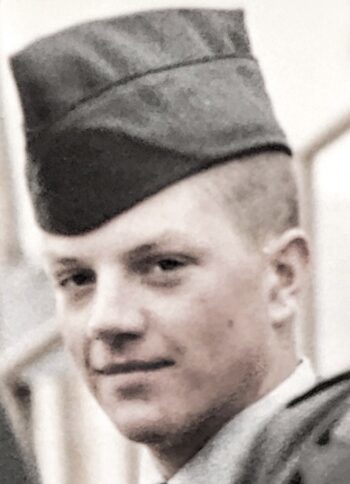 Daniel J. Smith
Daniel J. SmithDaniel grew up on a farm in Firelands, Ohio, not far from Vermilion, which is located on Lake Erie between Cleveland and Toledo. He had a tough time with math and English in high school, not knowing at the time that he was mildly dyslexic, making classwork difficult. He also had a tough time finding a place to fit in at his high school with all the cliques, so by the time he graduated in June of 1986, he was ready for a change.
The problem was Daniel saw his options as limited. He didn’t have the grades for college. He also didn’t want to work at the local Ford plant or Goodrich chemical plant because he wanted more potential for growth. His one ticket out was the Army, but there was a major drawback to that, too. He didn’t want to have to use a gun to kill—he wanted to help people instead.
Rather than giving up on his dream, Daniel called the Army recruiter who had visited his high school. The recruiter had him take the Armed Services Vocational Aptitude Battery (ASVAB) and he scored so high he was able to choose whatever he wanted to do. He opted for field medic, which was a perfect fit. His sole purpose in the Army would be helping people and it would allow him to get a fresh start in a new place. It would also earn him benefits under the GI Bill and the opportunity to attend college after he served. He signed his enlistment papers and agreed to give the Army the next three years of his life.
Daniel reported for duty to the Military Entrance Processing Station (MEPS) in Cleveland in the fall of 1986. After passing his physical and being sworn in, he was put on an airplane and sent to Fort Bliss, Texas, which was quite a change for him as he’d never ventured far out of Ohio before. He and a busload of recruits arrived sometime after midnight and were told to file off the bus, where they stood in the cold night air and snow flurries. After being berated outside for 45 minutes, the recruits flowed through two lines to get their hair roughly shaved and their uniforms issued. Daniel remembers trying to get to sleep in the barracks that night in an uncomfortable bed with the sound of other young men crying themselves to sleep. As someone with a strong personality who did not like to conform to authority, he thought his life was over—and this was just the first night.
The next day began with physical training and lots more yelling. Daniel couldn’t understand why the instructors had to act so mean. He remembers being singled out because, although he was an excellent athlete in high school, he did the fewest pushups in his company. Getting mocked really angered him, so he set out to prove the First Sergeant wrong. By the end of Basic Training, Daniel could do more pushups than anyone else in his company and was the most improved on the run and in sit-ups. Given his excellent performance overall, he earned the Soldier of the Cycle award.
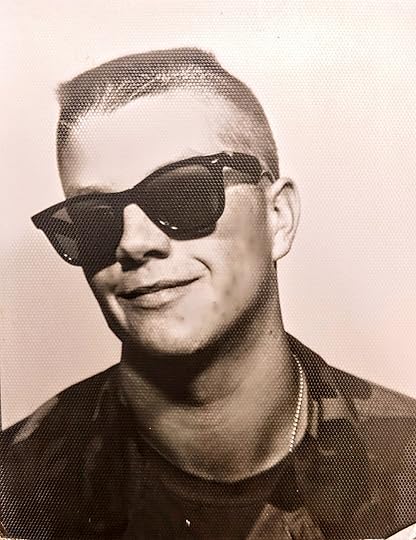 Daniel J. Smith
Daniel J. SmithAfter Basic Training, Daniel reported to Advanced Individual Training (AIT) for medics at Fort Sam Houston in San Antonio. As a medic, his job would be to keep wounded soldiers alive until they could be transported out of the area of immediate combat and be treated by a doctor. This meant he had to learn how to give IVs, do tracheotomies, stitch up wounds, and remove partially amputated limbs. His training lasted 4 months and he graduated 2nd in his class of 800 people.
Now a Specialist (E-4), Daniel reported to his first assignment, the 42nd Field Hospital in Fort Knox, Kentucky, during the late spring of 1987. Upon arrival, Daniel began training with his unit on how to quickly deploy and set up a 200 bed hospital. As the Army’s only deployable field hospital, the entire hospital could be packed and loaded onto transport aircraft, dropped into a landing zone, and reassembled in short order. However, since this was peacetime, the medics in the unit had to engage in other activities to keep their skills sharp. One of Daniel’s favorite training rotations involved working at the Ireland Army Community Hospital, where he worked in surgery, the Intensive Care Unit, and the Emergency Room. He found the toughest part of the hospital assignment was dealing with grief counseling.
Not all of Daniel’s training was medically related. In 1988, Kentucky was besieged by forest fires. Daniel’s First Sergeant asked his team whether anyone in the unit could drive a big truck. Having driven some stick shift farm equipment growing up in Ohio, Daniel volunteered. He soon found himself with a buddy driving a two-and-a-half-ton water truck through the mountains of Kentucky into the fire zone to help fight the fires. When the firefighters used up all of the water, Daniel would make another trip for more. He and his buddy often pitched in to help fight the fires in an effort to give some of the exhausted men on the front line a break.
At one point, Daniel and his buddy dozed off in the truck while they were parked in the fire zone. When they woke up, they found the truck surrounded by fire. Afraid they would be burned to death and that the truck would explode, they used water from the truck to clear a path back down the road to safety. It was a close call.
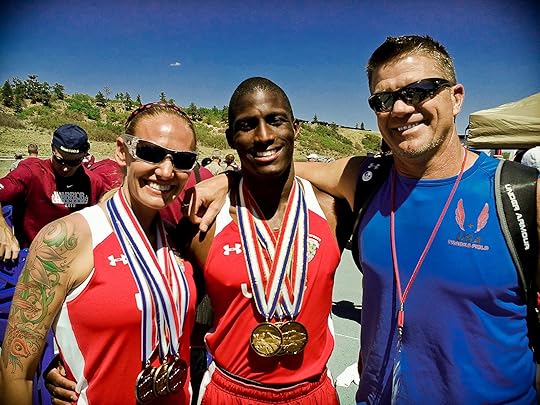 Daniel with Marine athletes at the 2012 Warrior Games
Daniel with Marine athletes at the 2012 Warrior GamesThe other significant training Daniel participated in consisted of two 3-month assignments each year with either the 82nd Airborne Division or the 101st Airborne Division at the National Training Complex (NTC) near Death Valley, California. NTC is a giant training area in the Mojave Desert, making it the perfect location for training U.S. forces for desert warfare. Daniel would be assigned as the medic for an airborne infantry unit and exercise with them under the intense temperature extremes of the Mojave Desert. The training was serious business and dangerous, as the following incident illustrates.
During one nighttime exercise, Daniel’s unit was convoying down a mountain in blackout mode, so drivers could only see the vehicle in front of them using night vision gear. Daniel was in the last vehicle in the convoy, which was typical since he was the medic. That way, if anyone had any medical issues, they could get out of their vehicle and wait for Daniel to come by. Daniel’s vehicle, however, was a Vietnam era M561 Gama Goat, which often broke down and was unreliable in the rocky terrain. Capping off the setting, Daniel’s driver was a devout Christian, so he was praying and praising Jesus out loud while he navigated the treacherous road at the rear of the convoy. Suddenly, there was a thud and the Gama Goat came to an abrupt stop—they’d hit a boulder and the vehicle’s front wheel broke off. Without a radio and in the pitch black darkness, they had no way to alert the other vehicles in the convoy, which continued driving unaware that Daniel’s vehicle had become disabled. Daniel and his driver stayed with their vehicle for 3 days with no food or water, watching out for scorpions, listening to the howls of a pack of coyotes surrounding them every night, and even scaring off a mountain lion, until a helicopter finally spotted them and they were rescued. Had the helicopter not seen them, Daniel is sure they would have died.
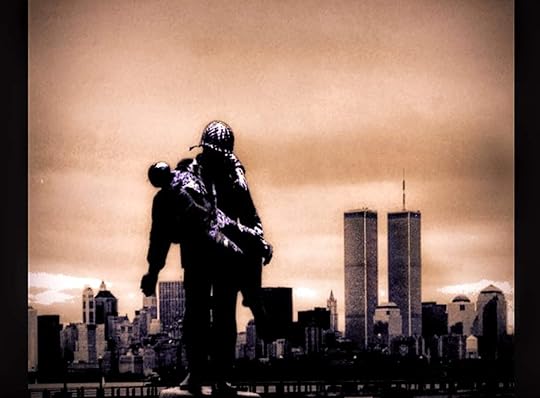 Photo taken by Daniel of the World Trade Center from Liberty State Park on September 11, 2000
Photo taken by Daniel of the World Trade Center from Liberty State Park on September 11, 2000Not everything Daniel did was training. On one occasion, he helped save an ROTC cadet who fell 80 feet into a ravine and onto her M16 rifle, breaking her back. On another occasion, he prevented a soldier from bleeding to death after his hands were crushed during repair work on a tank. In each case, Daniel was awarded an Army Commendation Medal for helping save the soldier’s life.
Daniel was discharged in the late summer of 1989 and returned to Ohio. He began working at a lakeside bar in Vermilion where lots of people from New York and New Jersey vacation. One day, two women at the bar asked him if he wanted to go to the beach with them and he accepted. At the beach, one of the women started setting up camera equipment and asked him if she could take a few pictures. That impromptu photo shoot led to Daniel entering a modeling competition in New York City, which he won in November of 1990. He then began a 14-year modeling career that had him doing photo shoots in countries around the world and castings with many top models and photographers.
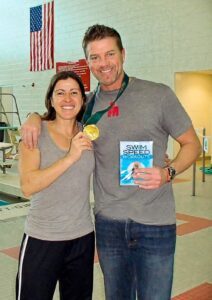 Gold Medalist Sheila Taormina with Daniel
Gold Medalist Sheila Taormina with DanielRecognizing he would not be able to model forever, Daniel learned the art of photography from the master photographers doing his shoots and he started his own photography business. He also began working out more intensely and fell in love with biking, swimming and running, so he was a natural for triathlons. In 2002, after he’d left New York and moved back to Ohio, the athletic and the artistic sides of his life merged into an opportunity to take photographs for an Olympic gold medalist swimmer, Sheila Taormina, who was writing what would turn out to be a worldwide best-selling series, Swim Speed Secrets.
In 2011, when Sheila and Daniel were promoting the Swim Speed Secrets series, they were given the opportunity to do a swim clinic for the U.S. Wounded Warrior Battalion in Colorado Springs. One week later, they were hired to coach swimming for the Marine Wounded Warrior team to prepare them for the international Warrior Games. The United Kingdom’s Prince Harry would subsequently throw his full support behind the games and their name was changed to the Invictus Games. Daniel served as the assistant swim coach for 2011, 2012, and 2013. He worked closely with many Wounded Warrior athletes from the United States and allied countries during those years and considers them to be some of the most rewarding years of his life. He still does swimming and triathlon clinics whenever needed.
Daniel continues to be an avid triathlon participant and, at 52, is a national-caliber master swimmer. More importantly, he coaches both track and field and swimming for Avon Lake High School, located on the outskirts of Cleveland. One student para swimmer he coaches was a silver medalist at the Parapan American Games and is currently training to qualify for the 2021 Paralympics in Tokyo. He also does an occasional modeling shoot, proving he still has it after all these years.
Voices to Veterans is proud to salute Sergeant Daniel J. Smith, U.S. Army, for his distinguished service in the 42nd Field Hospital and for his dedicated efforts working with Wounded Warriors. We are also thankful that he continues to work with high school athletes, helping them aspire to be the best they can be. We wish him continued success and fair winds and following seas.
 Daniel today in an Aquaman ad – he still has it!
Daniel today in an Aquaman ad – he still has it!
March 12, 2020
Specialist Billy Terrell, U.S. Army – Helping Children Devastated by the Vietnam War
Wars inflict pain and suffering—no one knows that better than Specialist Billy Terrell, U.S. Army. He saw war’s horrors firsthand and even heard a priest reading him his last rights as he lay on the brink of death in a field hospital in Vietnam. Yet Billy and the other members of his unit were able to look past the death and destruction to help South Vietnamese nuns carve out a sanctuary for one hundred children orphaned by the war. Looking back, Billy realizes the sanctuary saved him, too. This is his story.
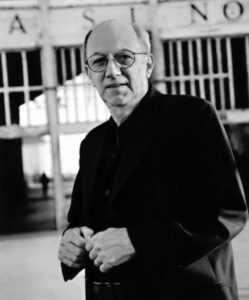 Billy Terrell
Billy TerrellBilly’s childhood can best be described as riches to rags. He was born in Newark, New Jersey, in 1944, to a solid middle class working family. His father owned a successful construction business, which at its peak employed 22 people. With two cars in the driveway and the only television on the street, it looked like Billy’s family was living the American dream. That dream came to an abrupt end in 1952 when the construction company went bust, thrusting Billy’s family into poverty. In the first of many moves over the next ten years, Billy’s father relocated the family to the coast near Asbury Park, New Jersey.
The move did not improve the family’s financial situation. Many nights, Billy and his siblings went to bed cold and hungry, while his troubled mother and despairing father proved unable to support their family. As if admitting defeat, Billy’s father made him quit school when he was 16 to find a job to help support the family. Dressed in rags and missing his four front teeth after they became brittle, broke, and had to be pulled, Billy found it impossible to find anything but the most menial low-paying jobs. That’s when his Aunt Laura came to his rescue by letting him live with her in Newark and paying for the dental work he needed to replace his missing front teeth. With the newfound confidence of a full smile, Billy set out to find a job and a way to get started in show business.
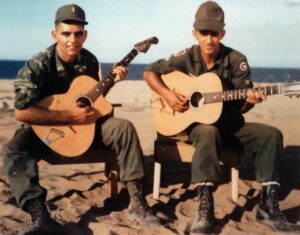 2d Lt Jordan Klempner and Billy playing guitar on the beach at Tuy Hoa in 1967
2d Lt Jordan Klempner and Billy playing guitar on the beach at Tuy Hoa in 1967Billy’s first break came when he was 17 working as a dishwasher at the Howard Johnson’s in Asbury Park. The bell captain from the nearby Empress Motel saw how hard Billy worked and got him a job bussing tables and delivering room service. Although he only had the first Monday off each month, Billy taught himself to play guitar and started playing gigs around town. Sometimes the acts performing at the Empress Motel would ask Billy to join them on stage to do a song or tell a few jokes. Clay Cole, the host of a popular New York TV show, saw Billy and said he had some people he wanted Billy to meet in New York. One week later, Billy, who now at 18 had Frankie Avalon looks and an infectious smile, signed with his first manager and did his first “demo” record. Although he didn’t get a recording contract, he inked a deal as a songwriter with Kama-Sutra Productions for $50 per week. By the middle of May 1965, The Duprees had recorded Billy’s first song on Columbia Records, They Said It Couldn’t Be Done. It looked like Billy was finally on his way, but Uncle Sam had other plans.
In May of 1965, Billy received his draft notice and notified his employer that he would soon have to leave for the Army. The people at Kama-Sutra Productions didn’t want him to go, even holding a séance for him in a blacklight lit room with a beatnik talking in tongues and banging on a gong. When the séance didn’t change Billy’s mind, they suggested he report for duty in women’s underwear and holding a dead fish. Having none of it, Billy thanked the staff for their concern, but told them that his grandfather had immigrated to the United States in 1902 from Italy and made a life for himself and his family, so he felt it his duty to serve his country in the Army. Billy said goodbye and walked out of Kama-Sutra Productions—his grandfather died the next day.
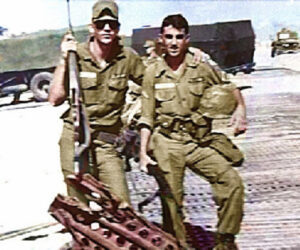 Johnny Young of Bayonne, New Jersey, and Billy at Phan Rang in 1966
Johnny Young of Bayonne, New Jersey, and Billy at Phan Rang in 1966The Army delayed Billy’s report date so he could attend his grandfather’s funeral, but on August 5, 1965, it was time to go. Billy reported to the Military Entrance Processing Station (MEPS) in Newark. From there he was bussed with his fellow draftees to Fort Dix, New Jersey, for 8 weeks of Basic Training. Although it was tough, Basic Training gave Billy a sense of self-worth he had never had before. Now he was part of a team, had a clean uniform to wear and three meals a day to eat. He started to become healthier and gain weight, and developed a sense of pride in what he was doing. At the same time, he recognized what he and all of the other draftees had in common. They were all poor and uneducated, from the bottom rung of society. Despite his new-found pride, he couldn’t help but think society thought them expendable. Billy would wrestle with this dichotomy throughout his time in the Army.
After completing 8 weeks of Basic Training and 8 more weeks of Advanced Infantry Training (AIT) at Fort Dix, Billy and a friend he made at Basic Training, Bob Reed, reported to Quartermaster School at Fort Lee, Virginia. Quartermasters manage the Army’s logistics and supply chain, making sure the fighting forces have what they need to win battles. Billy and the other soldiers trained for 4 weeks, making ready for assignments in Vietnam.
Part of the preparations included an orientation to duty in Vietnam, where the instructor told the new soldiers that they could not ship their cars to Vietnam and that their families could not visit them there. This offended Billy because it was obvious they could not do these things—Vietnam was a war zone. Irked that whoever prepared the orientation must have thought that he and the other trainees were ignorant, Billy stood up when the instructor asked if anyone had any questions. He said, “you’ve told us throughout training that in South Vietnam, we can’t tell who the enemy is because the Viet Cong have infiltrated the villages. Why don’t we just go into North Vietnam and get this over with?” The instructor didn’t appreciate Billy’s strategic thinking and sent a sergeant over to tell him to sit down, which he did.
The night before Billy’s Quartermaster class was to ship out, a sergeant and some Military Police roused Billy, his friend Bob Reed, and 2 others. The sergeant told them to pack their gear as they were moving out now. Not knowing what was going on, the men gathered their gear and went with the sergeant to the train station, where they were put on a train for Fort Riley, Kansas. There they joined the 96th Quartermaster Battalion, which would soon deploy as a unit to Vietnam. By May of 1966, the unit was ready. After transferring to Oakland, the men in the unit boarded the USNS General Nelson M. Walker (T-AP-125), a World War II era transport ship, en route to Vietnam.
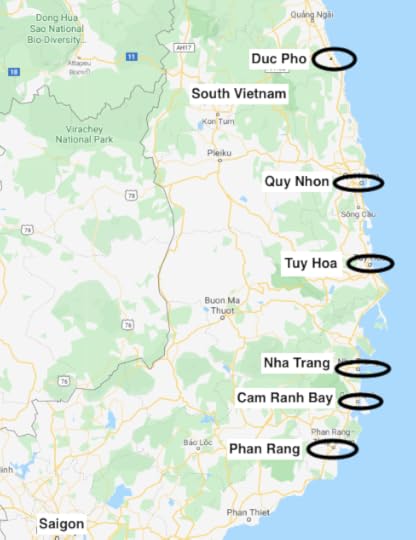 Map showing locations relevant to Billy’s tour in Vietnam
Map showing locations relevant to Billy’s tour in VietnamThe ship arrived in Cam Ranh Bay, Republic of South Vietnam, on May 28, 1966. Billy was ferried ashore in a Navy LCU (landing craft – utility). He and Bob Reed made it a point to take their first step onto Vietnamese soil together. Once everyone was ashore, the battalion broke into 2 companies, with Billy being assigned to the 226th Supply and Service Company. The unit spent a few days in Cam Ranh Bay and then drove by truck to Phan Rang, about 80 kilometers northeast of Saigon, where they set up camp. Billy remembers the camp being an isolated jungle setting not far from shore, with waste high grass all around the camp.
Phan Rang was a staging area for the company, so they had little to do other than prepare for their next assignment. This exacerbated racial tensions, which tended to surface when the men had free time on their hands. The unit included white soldiers from the South and African American soldiers from the North, and they did not get along. The unit also had members who had been given the choice of joining the Army or going to jail after committing violent crimes, so maintaining discipline was difficult. At night it could be particularly scary, with junior officers and sergeants sometimes being attacked and beaten. Billy was able to get along with all groups, because he had life experiences in common with both the enlisted soldiers and the officers, so he was left alone. Still, the racial tensions complicated an already dangerous wartime environment.
At the end of July 1966, Billy and the rest of the 226th Supply and Service Company embarked a Navy vessel and sailed up the coast to Tuy Hoa, which would be their supply base camp for the remainder of Billy’s tour in Vietnam. The first order of business was to set up tents to live and operate out of. Then they laid down a metal landing surface to allow supply aircraft to land and take off from the camp.
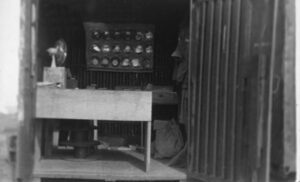 Billy’s Conex Box Post Office in Tuy Hoa
Billy’s Conex Box Post Office in Tuy HoaBilly was responsible for handling the unit’s mail, so he convinced the Company Commander, Captain Virgil Bon, to allow him to set up a post office in a Conex box. He used tin cans labelled alphabetically to sort letters, which he would then deliver to the men in his unit. He also flew by helicopter to units all around the area to deliver mail, sometimes bringing an added surprise like cans of soda on ice to the men in the field. More than once a cold soda resulted in a hug from a grateful recipient. Despite these lighter moments, the delivery runs were deadly serious. On more than one occasion, Billy remembers hunkering down in the helicopter while the machine gunner blasted away at targets below with the aircraft’s M-60 machine gun.
Billy also stood perimeter guard duty at night, which could be terrifying not only because it was so dark, but also because he was isolated and easy prey for the convicted felons who really didn’t want to be in the Army. Viet Cong infiltrators were also a concern, but primarily because they wanted to interrupt a fuel pipeline running from the beach to the base. One bright moonlit night, Billy heard tapping on the pipe, so he slipped out of the bunker he was manning and took cover in the nearby brush just in case the bunker was being targeted. The enemy did not attack, but it was a terrifying experience, nonetheless.
Life was also made difficult because Billy and the other soldiers could not trust the local population, who were friends by day and Viet Cong sympathizers by night. Vietnamese locals, who often worked at the camp, sometimes planted grenades and other charges among the pallets of supplies. When the forklift operators tried to move the pallets, they were injured or killed. The roads around the camp were also mined, so soldiers were always at risk of stepping or driving on a mine. The lack of trust flowed both ways as some of the more out of control soldiers tormented the locals. On one convoy driving along a narrow dirt road, Billy saw a truck driver intentionally swerve toward an ox pulling a cart carrying a farmer and his family. The animal panicked and bolted, throwing the farmer’s family under the truck, where they were crushed. The anguished cries of the farmer distraught over the death of his wife and children still plague Billy.
In the midst of all this suffering, a ray of hope cut through the war and brought life to everyone it touched. One afternoon in September 1966 when Lieutenant John Sheer was burning inedible C-rations, they discovered two nuns picking through the cans and scavenging for food. Lieutenant Sheer told the nuns, who spoke no English, that the food was bad and gave them $10 worth of military scrip to buy some food. An hour later they returned with a priest who spoke some English and could explain to Lieutenant Sheer the nuns’ plight.
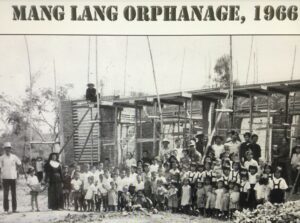 Mang Lang Orphanage under construction
Mang Lang Orphanage under constructionThe priest explained that the nuns ran the Mang Lang Orphanage, which had been destroyed by the Viet Cong. They had escaped with about 100 children and were now jammed into the tiny wing of a ramshackle hospital near town. Lieutenant Sheer asked Billy to go with him to visit the site. When they saw it, they were immediately convicted to help Sister Michelle and Sister Teresa with the orphanage. They began by setting out cigar boxes around the camp where soldiers could contribute money. Lieutenant Sheer also asked his church in Chicago to donate. Within a few weeks they had collected $600, which was enough for the nuns to buy land and build a new orphanage.
That wasn’t all the men did. Lieutenant Sheer, Billy, and other members of his unit became frequent visitors. Billy took the children chocolate he’d traded other soldiers for in return for the cigarettes he received in his C-rations. He also taught the boys, who were all under 10, to play baseball. Every time Billy visited, the children ran to him and clung to him when he had to go.
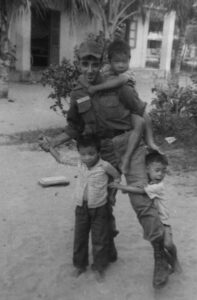 Billy with boys from the orphanage in 1966
Billy with boys from the orphanage in 1966The Mang Lang orphanage became a sanctuary for the children, where they actually had enough to eat and people who loved them. Just as important, the orphanage became a sanctuary for Billy and the other soldiers of the 226th Supply and Service Company, offering a lifeline to humanity in the middle of so much death and destruction.
In December 1966, Billy participated in a convoy led by soldiers from the 28th Regiment of the South Korean Army, who provided tenacious security for Billy’s base camp. As the convoy drove through the heavy monsoonal rain, Billy became delirious and ran a high fever. The Korean officer in charge of the convoy ordered that Billy be taken to the 563rd Medevac Company, which had a landing zone for casualty evacuation helicopters (“Dustoff choppers”) on a hill north of Tuy Hoa. The plan was to evacuate Billy to the 67th Evacuation Hospital in Quy Nhon, but the rain was too heavy for chopper operations. With the only tent already full of casualties, Billy and several other evacuees were wrapped in ponchos and left outside in the rain until morning. When the weather cleared, Billy was flown to the 67th Evacuation Hospital, and subsequently transferred to the 8th Field Hospital in Nha Trang, where they had the expertise to treat him.
By the time Billy arrived, he was baking with a 105-degree malaria-induced fever and hallucinating. The doctors said they had to bring his fever down or they would lose him, so they gave him an ice bath, which was incredibly painful. Moreover, when they removed his right boot, they found a hole through his foot between two of his toes and his skin rotting to the point where his shin bone was visible. After the ice bath, Billy remembers being put to bed and overhearing a doctor instruct the nurses to take his temperature every 30 minutes, give him a shot every hour, and if he makes it until morning he might have a chance.
Although his eyes were swollen almost completely shut, Billy could see USO Christmas lights decorating the hospital tent. Evoking strong emotions even now, Billy remembers staring at the Christmas lights and repeating over and over, “Oh my God, what is my mother going to do?” He was afraid that if he closed his eyes and fell asleep, he would die. Eventually he passed out. Later he saw an intense light and thought he must be dead. He jokes now that he started looking around for lost relatives, but seconds later he realized the bright light was the sun peeking through a gap in the sandbags surrounding the tent. He’d made it through the night!
Later in the day, Cardinal Francis Spellman (the Roman Catholic Vicar of the U.S. Armed Forces), the great evangelist Billy Graham, and motion picture star and comedienne Martha Raye, visited Billy. Reflecting that Billy was still in very serious condition, Cardinal Spellman administered him his last rights while Billy Graham held his hand and Martha Raye held his feet. Cardinal Spellman also gave Billy a crucifix, which he took home from the war.
After a day or so, the doctors told Billy he had to start walking to help circulate his blood or he would not make it. He was so weak, though, that he couldn’t even lift the heavy end of a spoon from a tray to feed himself. Then Martha Raye, who the soldiers affectionately called “Colonel Maggie”, reappeared at his bedside. She repeated what the doctors told him and said he wasn’t going to die on her watch. Then she helped Billy stand and told him to put his feet on hers and she walked him across the room. She visited at least one more time and did the same thing, until finally Billy gained enough strength to walk. Billy is certain that if Colonel Maggie had not come by to help him, the malaria would have killed him.
Although reduced to 89 pounds and looking like a living skeleton, Billy began to recover. He wondered whether he would be sent to the Philippines or Japan before going home, but the Army had other plans. His doctor informed him that he was being sent back to his unit. Billy asked how that could be given his weight and that he’d been in the hospital for over 30 days. The doctor countered that Army regulations required that he be returned to his unit because he’d not been in the same hospital for over 30 days. Knowing that he couldn’t fight the man and reminded of his Boot Camp feelings of being expendable, Billy shrugged it off and returned to his unit to finish out his tour.
Nearing the end of his tour, Billy and his friend, Lieutenant Jordan Klempner, flew in a Huey helicopter from Tuy Hoa north to a fire base near Duc Pho, where the helicopter came under fire. The pilot guided the helicopter to a landing zone behind four 105mm howitzers firing rounds at the enemy. Billy and Lieutenant Klempner jumped to the ground before the helicopter peeled away. They ran toward a group of vehicles assembled nearby and boarded a three-quarter ton truck in a convoy heading to Duc Pho. As they passed through several hamlets along the way, Billy sensed something wasn’t right and laid down on the bed of the truck with a round chambered in his rifle. Lieutenant Klempner, who was still standing in the back of the truck, asked Billy what he was doing. Billy said it was too quiet—he couldn’t hear birds anymore—just the sound of the trucks. Lieutenant Klempner got down too and moments later, gunfire erupted at the front of the convoy, killing the lead driver. A firefight ensued, pinning down Billy and Lieutenant Klempner. Eventually, two jets dropping napalm suppressed the attack and the convoy was able to continue to Duc Pho, carrying its dead and wounded. The next day, Billy and Lieutenant Klempner returned to the landing zone in a column of vehicles that included tanks at the beginning and the end, with a Huey helicopter gunship overhead spraying the terrain on both sides of the road with M-60 machine gun fire. After returning to the landing zone, Billy and Lieutenant Klempner flew back to Tuy Hoa. Billy considers the attack on the convoy on the road to Duc Pho to be his most trying experience of the war.
Because Billy only had a few days left in country, Captain Bon sent him to the relative safety of Cam Ranh Bay to await his flight back to the States. When he boarded the chartered Northwest Orient airliner for home, he was surprised to see his friend, Bob Reed, on the flight. Everyone onboard, from the most junior soldier to the most senior officer, sat in silence as the plane took off, all instinctively with their eyes closed and holding hands. When it was clear the plane was out of range of any danger, the men erupted in cheers, hugging and tears. They had survived their tours in Vietnam. The date was May 29, 1967–they were finally going home.
Once back in the States, Billy faced many challenges. The first came when he went home and learned his father had suffered a serious heart attack while he was gone. Billy initially felt responsible because he believed the news of his near death experience from malaria had been the cause. The second challenge came from the way everyone treated him. He had grown up watching World War II movies and saw the welcome home the troops received. He expected the same, wearing his uniform around town when he first arrived home. Instead of being welcomed, people rejected him.
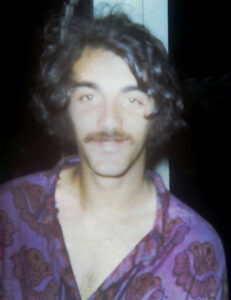 Billy Terrell in 1968
Billy Terrell in 1968Dejected and suffering from the trauma of war, Billy turned to the bottle. Things got so bad that at one point, he traded the crucifix he’d been given in the field hospital in Vietnam for a drink. He reached rock bottom on June 23, 1968, when he showed up drunk and disheveled for his brother’s wedding. Afterwards, he looked at himself in the mirror and felt like a disgrace. He’d survived the war and made it home to his family. Thousands of other soldiers hadn’t been so lucky. Out of respect to them and their mothers, he had to fix himself. He gave up drinking that day and set his sights on getting back into the music industry. That meant finding a cheap office in Asbury park and buying a broken down piano for $25, which he taught himself to play by practicing up to 20 hours a day.
Five months later, singer Debbie Taylor took a song Billy wrote, Never Gonna Let Him Know, to #5 on the R&B chart. Billy never looked back. Over the course of his career, he wrote, arranged, and/or produced over 2,000 records, with 64 hitting national and international charts. He produced records for the likes of Bobby Rydell, Helen Reddy and Maria Muldaur, and helped rekindle the career of his teen idol, Frankie Avalon, in the 1970s by creating a disco arrangement of Frankie’s 1959 #1 hit song, Venus. The 1976 hit helped Frankie land the role of Teen Angel in the blockbuster movie, Grease.
Despite all of his post-war success, Billy still had a few more scores to settle. He’d moved forward with his life after his brother’s wedding by trying to suppress his memories of the war, only to have them continue to torment him. Agent Orange also took its toll, afflicting him with several forms of cancer, all of which he’s beaten. His ultimate success came when he realized he continued to suffer from PTSD and sought counseling with other veterans to address it.
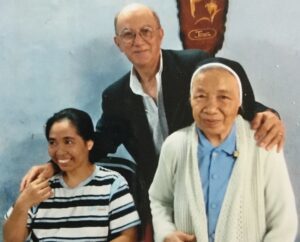 Billy with Sister Michelle and Ahn Doe at Mang Lang Orphanage in 2013
Billy with Sister Michelle and Ahn Doe at Mang Lang Orphanage in 2013In 2008, Billy found a trove of photographs of the Mang Lang orphanage he’d taken during the war. Curious, he searched the Internet and discovered the orphanage was still there, as was Sister Michelle. Then he did something he thought he would never do—he returned to Vietnam to visit the orphanage and confront some of his demons.
Billy’s visit to the orphanage in 2013 was life-changing, once again providing him with a sense of peace and sanctuary. He met with Sister Michelle, now in her 80s, and 4 women who remembered Billy from his visits when they were children during the war. One of the women, Ahn Doe, who had deformed feet, had been dropped off at the orphanage by her family because they didn’t want to raise a disabled child. During Billy’s 2013 visit, she told him through an interpreter that she loved the sweets Billy used to bring during his visits to the orphanage and that when Billy held her, it was the only time she ever felt safe. Ahn’s revelation brought Billy to tears, as he realized his efforts had made a difference. It was the beginning of the healing process.
Now semi-retired, Billy freely shares his story with civic groups, veterans organizations, and schools. He’s even written his memoir, The Other Side of Rock and War, published by the National Foundation of Patriotism in 2018. If you’d like to learn more about Billy’s amazing life, including stories about the rock and roll legends he’s encountered like Jimi Hendrix, Jim Morrison, George Harrison, Ravi Shankar, Cream, and Janis Joplin, I encourage you to read his book, which is available through Amazon and Barnes and Noble.
Voices to Veterans is proud to salute Specialist Billy Terrell, U.S. Army, for his dedicated service to our country during the Vietnam War. Not only did he do all the Army asked of him and more, he epitomized the honor and dignity of the American soldier through his kindness to Vietnamese orphans whose lives had been upended by the war. Billy gave the most vulnerable victims of the war hope and made them feel safe, changing their lives forever. He continued to change lives after returning home by bringing smiles to people’s faces through his music. For all he has done throughout his life, we thank Billy and wish him fair winds and following seas.
 Billy Terrell’s Memoir – The Other Side of Rock and War
Billy Terrell’s Memoir – The Other Side of Rock and War
February 8, 2020
Specialist Jack Murphy, U.S. Army – Saluting Fellow Veterans with a Heartfelt Song
Veterans instinctively understand each other. No matter who they are, where they come from, what their rank was, or what they did in the military, there is an unshakable bond between them. Explaining that bond can be difficult, but some people are gifted in conveying it in ways that help others understand. Specialist Jack Murphy, U.S. Army, has the gift. Twenty-five years after surviving war in the rice paddies and jungles of Vietnam, Jack wrote a moving tribute to his fellow Vietnam veterans called The Promise. The song has touched the hearts of thousands and was played during the Memorial Day remembrance ceremony at the Vietnam Veterans Memorial in Washington, DC, in 1996. Jack could not have written The Promise without first having lived its lyrics. This is his story.
Jack was born and raised in Croydon, Pennsylvania, a small town about 20 miles north of Philadelphia. His father was a World War II veteran, having landed on Omaha Beach at Normandy and later fighting in the Battle of the Bulge. After the war, he worked for the Kaiser-Fleetwings Aircraft Company in Bristol, Pennsylvania. His mother stayed at home raising Jack and his brother and sister. Jack attended Delhaas High School and was really into music. He played in a number of bands outside of school.
By the summer of 1968, Jack could see the writing on the wall. He was working at a local cigar factory and all the young men his age were being drafted. He knew it would be only a matter of time before his number came up, too, so he tried to convince 3 of his buddies to enlist with him. After a few days of arm-twisting, all 4 young men went to the local recruiting center to join the Army. They took an aptitude test, signed a few papers, and it was official—they owed the next 3 years of their lives to Uncle Sam.
Jack and his friends reported to the Military Entrance Processing Station, or MEPS, in Philadelphia, on September 26, 1968. There they were given a physical exam, sworn into the Army, and loaded onto a train en route to Fort Bragg, North Carolina, for Basic Training. As an 18-year-old kid traveling with his friends on a train, Jack found the whole experience exciting. All that changed when they got off the bus at Fort Bragg and met their platoon sergeant for the first time. They were definitely in the Army now.
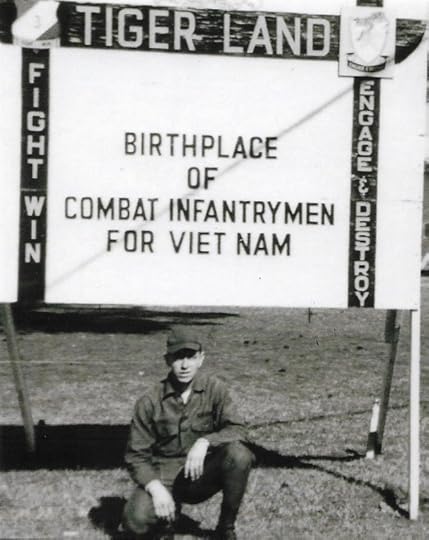 Jack Murphy at Tiger Land at Fort Polk, Louisiana
Jack Murphy at Tiger Land at Fort Polk, LouisianaBasic Training is still ingrained in Jack’s memory. He and his friends were assigned to the same platoon, so they were able to spend the next 8 weeks together learning to become soldiers. One of the hardest parts for Jack was the physical training because he was not an athlete in high school. He was more into music and hanging out on the corner “looking good”. He and his friends managed to get through it, but graduation was where they parted company. Jack’s three friends went to helicopter schools, while Jack went to Advanced Infantry Training (AIT) at Fort Polk, Louisiana. Jack was on his own.
The AIT training at Fort Polk was known as “Tiger Land”. Its purpose was to train American soldiers how to fight and survive in Vietnam’s jungle environment. Jack describes it as “rough, very rough”. There he learned to conduct ambushes and to respond when caught in one. He also learned how to spot boobytraps by navigating through a course with boobytraps hidden along the route. Jack knew he had to master the skills if he was going to come back from Vietnam alive.
By the beginning of February 1969, training was over and it was time for the real deal. Jack went home for 30 days leave and at the end, said goodbye to his family at the airport in Philadelphia. His father, knowing better than most what Jack was about to go through, simply said “be careful” as tears welled up in his eyes. His mother was less restrained and cried openly. Jack then boarded the plane for the first leg of his trip to Vietnam.
Jack’s plane landed at San Francisco International Airport. From there, he went to Travis Air Force Base, where he boarded a chartered plane along with lots of other replacement soldiers headed to Vietnam. The plane landed at Tan Son Nhut Air Base in the Republic of South Vietnam on March 5, 1969. When the door opened, the heat, humidity and smell of diesel fuel rushed in, engulfing Jack and the rest of the new arrivals. It was so overpowering, Jack remembers thinking “what kind of place is this?” He didn’t have long to think about it, because soon after he got off the plane, he and the other replacements were loaded onto a bus heading for the sprawling U.S. base at Long Binh. The bus windows were covered by a metal mesh to prevent grenades from being tossed inside—a grim reminder of the serious business Jack was about to become involved in.
At Long Binh, Jack reported to the 90th Replacement Battalion. As a replacement soldier, Jack did not know what operational unit he would be assigned to. Instead, he and the other replacement soldiers were temporarily assigned to the 90th Replacement Battalion to await their permanent assignment. While there, they in-processed and received additional instructions about their time in Vietnam, but mostly they waited anxiously until their name appeared on a bulletin board identifying the unit they would be joining. Jack only had to wait a couple of days before his name appeared. His new assignment: the 199th Infantry Brigade (Separate) (Light).
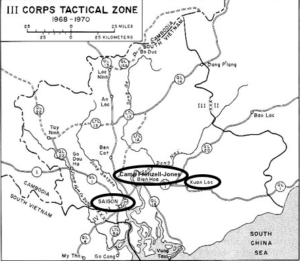 III Corps Area of Responsibility 1968-70 (Source: U.S. Army)
III Corps Area of Responsibility 1968-70 (Source: U.S. Army)Jack was not the only replacement heading to the 199th Infantry. He and the other new arrivals climbed aboard trucks and headed for the 199th Infantry’s main base at Camp Frenzell-Jones. Once there, they went through a week of boobytrap and rifle range training, made more intense than their stateside training with the realization that now their lives depended upon it. With the refresher training under his belt, Jack boarded a CH-47 Chinook helicopter and headed out to Delta Company of the 5th Battalion, 12th Infantry, which manned a company-sized fire base in the rice paddies of the Mekong Delta.
When Jack arrived at the fire base, he was assigned to a squad and a bunker. As he started to talk to the men in his squad, he found them helpful, but they kept their distance. That is, they told him what to watch out for, but he soon realized they didn’t want to become close because they’d already lost too many friends. They told Jack to listen to the guys who’d been there a while and do what they did and he’d get through it. In other words, if Jack wanted to survive, he had to learn fast.
When it came time to bed down for the night, everyone laid down on the ground outside the bunker. Already concerned he was going to have trouble sleeping during his first night in the field, he asked why no one was sleeping in the bunker. His squadmates told him they slept outside because there were giant rats in the bunker. Later that night, the Viet Cong launched rockets at the fire base and everyone except Jack took cover in the bunker. Someone inside the bunker shouted at him to get inside, but he responded, “You told me there are rats in there.” The voice called out again, “Get in here, you dumbass. Would you rather get blown up or deal with the rats?” Jack joined his squad in the bunker.
The next day, Jack was assigned to work on a detail outside the wire (meaning outside the protective perimeter of the fire base) eliminating trees so there would be a clear field of fire around the base. After working for a while, his group was instructed to return inside the wire because a patrol was returning and they didn’t want any misidentifications or friendly fire incidents. When Jack returned to the camp, he saw the patrol emerge from the tree line. He asked the First Sergeant if that was the patrol they were expecting and just as he did, the returning patrol’s point man stepped on a Viet Cong boobytrap armed with a 105-millimeter artillery shell. At that exact moment, reality set in for Jack. He and those around him could be killed at any minute. All he could do was accept it and hope.
The next day, Jack joined his patrol on his first search and destroy mission, wading off through the rice paddies from the relative “safety” of the fire base in search of Viet Cong. The route took them over the area where he’d witnessed the boobytrap detonate the day before, only now it was he who was trudging through the dangerous terrain. On all such missions, the squad had to be ever vigilant, trying to detect and avoid the boobytraps they knew were there but could not see.
During the first three months of Jack’s tour, his squad deployed to different fire bases, sometimes using Boston Whalers and airboats to move around. Each of the airboats had a driver and a person riding shotgun to watch for snipers and boobytraps. On one occasion when Jack was preparing to go out on a patrol via boat, he learned that the person riding shotgun was going home, so they needed someone to replace him. Jack volunteered. After Jack and the driver dropped off the patrol, they returned on June 2nd, 1969, to take the patrol some cases of rations. When Jack got off the boat to deliver the rations, he set off a boobytrap, wounding him and 5 others. He had to be evacuated to the 3rd Army Field Hospital in Saigon, where he spent 2 weeks, and later to Cam Ranh Bay for 2 additional weeks. Jack would never volunteer for anything again. The only bright spot occurred in the 3rd Army Field Hospital when a famous singer from the 1930s-1950s, Tony Martin, visited Jack’s ward after a show and pinned a Purple Heart on Jack and the other wounded soldiers.
After completing his recuperation at Cam Ranh Bay, Jack returned to the 199th Infantry at Camp Frenzell-Jones. As soon as he arrived, he learned that the unit was being deployed to the vicinity of Xuan Loc, northeast of Saigon in the III Corps area of responsibility. His new outpost was Fire Base Libby, located in dense triple canopy jungle. This came as a shock to the men in the unit, as they were used to fighting the Viet Cong in the rice paddies of the Mekong Delta and now they were being asked to fight North Vietnamese regular soldiers in the jungle. The new assignment called for different tactics but was just as dangerous—Jack’s unit sustained casualties on the first night it arrived.
Although the enemy, the terrain, and the tactics were different, the unit’s search and destroy function was the same. Jack and the other 16-20 members of his platoon would set out from Fire Base Libby and patrol in the field for 15-20 days, seeking to engage the enemy. At the end of that time, they would return to the fire base for 3 days to rest, get showers and clean clothes, and gear up for the next patrol. On these patrols, the danger was not so much from boobytraps as it had been further south, but from engagements with North Vietnamese units. This was Jack’s life for the next 6 months.
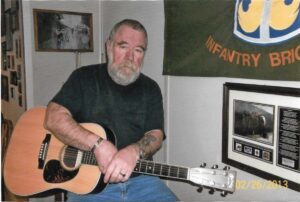 Jack with his guitar at home
Jack with his guitar at homeWith 30 days to go on his Vietnam tour, Jack was able to take advantage of an Army program to help him earn his GED. Not only would this get him his high school diploma, but it also had the significant benefit of getting him out of the field. He studied for his GED during his final month in Vietnam, and he would later finish it at Fort Dix, New Jersey, after returning to the United States.
Jack finally left Vietnam on March 5, 1970, one year to the day after he arrived. He considers that day to be the best day of his life. He departed from Tan Son Nhut Air Base, retracing his steps through Travis Air Force Base, before flying home to his family in Philadelphia. He still had 2 years to go on his 3-year enlistment, but the Army allowed him to work off the remainder of his commitment in the Fort Dix Commissary, which was quite a change from humping through the jungle as a radio-telephone operator just trying to stay alive. Jack was honorably discharged from the Army on November 2, 1971. His three friends who enlisted with him on September 26, 1968, also survived the war.
After the war, Jack returned to small town life north of Philadelphia. He married and had 2 children, and took a job working at a steel mill for U.S. Steel. After 10-11 years, the market for American steel dried up and the mills closed, so Jack found a new job driving for the medical clinic at the Willow Grove Naval Air Station. He eventually retired from that position.
Although Jack left Vietnam in 1970, Vietnam did not leave him. In fact, he’d been going to the Vietnam Veterans Memorial in Washington, DC, every Memorial Day and Veterans Day for years to pay his respects to his fallen comrades. He’d also wanted to write a song about his experience in Vietnam, but the inspiration wasn’t there. Then, one night in 1995, the inspiration suddenly came. Jack picked up his guitar, turned on his tape recorder, and in 15 minutes created the music and lyrics for The Promise. He took the tape to a producer at a local recording studio who liked it so much he wanted to produce it. They spent the next 2 hours recording the final version. The Promise was later played during the 1996 Memorial Day Ceremony at the Vietnam Veterans Memorial. Since then, the song has spoken to thousands of veterans and their families about the lasting impact the Vietnam War has had on those who fought and served.
Voices to Veterans is proud to salute Specialist Jack Murphy for his service in the U.S. Army during the Vietnam War. Despite being in constant danger and threat from enemy fire, Jack did his duty with bravery and distinction. Most important, he’s never forgotten those he served with, standing side-by-side with them in time of war and preserving their memory after his return. We thank Jack for his unselfish service to our country and wish him fair winds and following seas.
Now, please enjoy the song The Promise, by Jack Murphy:
January 18, 2020
Lt. Col. John W. Heimburger, U.S. Air Force (Retired) – Staying One Step Ahead of Disaster in Vietnam
Military pilots are a breed apart. They are risk takers and, at least by my standards, fearless. They aren’t satisfied with just getting by—they need to grab life by the reigns and live it on the edge. That description fits Lieutenant Colonel John W. Heimburger, U.S. Air Force (retired), to a tee. From being awarded the Silver Star in Vietnam to climbing some of the highest mountain peaks around the world, John has done it all. Even more important, John has lived a life of service to his country and his community. I could tell when I was interviewing him that I was speaking to a great American. This is his story.
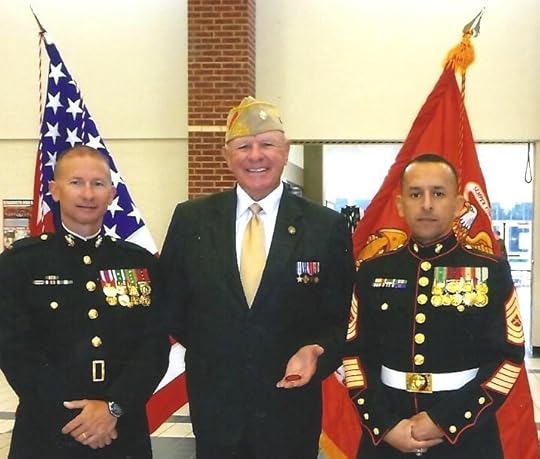 Lt. Col. John Heimburger and 2 Marines at a local high school ceremony
Lt. Col. John Heimburger and 2 Marines at a local high school ceremonyJohn was born in 1941 and raised in Tolono, Illinois, just a few miles south of the University of Illinois in Champaign. His dad did everything from drive a gasoline delivery truck to serve as the chief of the local fire department, while his mom worked at home raising John and his brother and two sisters. John learned the value of work at an early age, distributing grocery store handbills and earning a penny for each one delivered. He later became a paperboy for the Champaign-Urbana Courier. His paper route not only allowed him to save enough money to buy a bicycle, but it led to an event that changed his life forever.
When John was 14, he won a trip to Washington, DC, by recruiting new subscribers for the newspaper. One of the sites he visited during the trip was the U.S. Naval Academy in Annapolis, where he witnessed the plebes (first-year midshipmen) trying to scale a greased granite monument to place an officer’s hat on the top. Not only was it entertaining, but the midshipmen’s spirit, camaraderie, and teamwork also really made an impression on John. Later in the trip, John’s group had its picture taken on the Capitol steps with Congressman William Springer, who represented Tolono in the U.S. House of Representatives. Congressman Springer asked John what his favorite part of the trip was, and John told him it was his visit to Annapolis. When Congressman Springer heard this, he asked if John would like to go there. John said yes. Then the Congressman asked if John would like to be a pilot. John again said yes. Congressman Springer concluded by saying, “Have your parents call me in 3 years when you are ready to go to college. We’ve got a new Air Force Academy in Colorado and I can help you attend.”
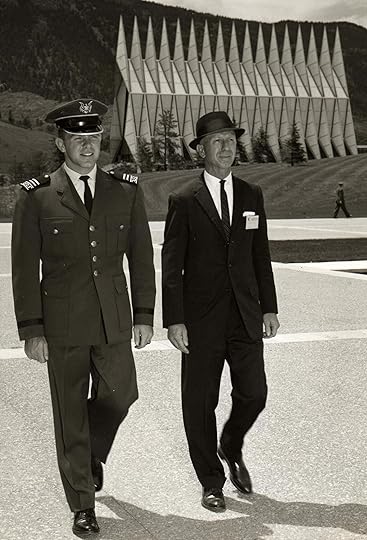 Cadet John Heimburger and his father at the Air Force Academy
Cadet John Heimburger and his father at the Air Force AcademyThree years later, after graduating from Unity High School in Tolono, John reported to the new Air Force Academy just north of Colorado Springs as part of its fifth class, the “Golden Boys”. He credits his success at the Academy to his parents for raising him with a sense of personal discipline and to the Boy Scouts for giving him the self-confidence and leadership skills he needed. He dove right into Academy life, playing defensive end on the football team and even meeting Navy great, Roger Staubach, on the gridiron. He also excelled at field hockey and was invited to join the U.S. Field Hockey Team for the 1964 Olympics in Tokyo. As if that wasn’t enough, he sang in the Cadet Chorale, marched in President John F. Kennedy’s inaugural parade, and received his diploma with President Kennedy standing nearby. After graduating, he married Susan Young, to whom he was happily married for 18 years, in the Air Force Academy Chapel.
John next reported for flight training at Reese Air Force Base in Lubbock, Texas. There he spent approximately 13 months learning to fly the Air Force’s first supersonic capable training jet, the T-38 Talon, which had only recently been introduced. John loved to fly and it soon became clear he was a natural pilot. He also liked to press the envelope, and on one occasion just after he soloed, it almost cost him dearly.
On that occasion, John flew his T-38 near its ceiling of 48,000 feet, turned off its IFF transmitter so his altitude could not be tracked from the ground, and put his plane into a dive. Once he got the jet going fast enough, he pointed the plane’s nose upward with afterburners on to see what would happen when he went above 48,000 feet. When he reached 53,000 feet—an altitude where he could see the curvature of the earth—one of his two jet engines shut down. Although he managed to restart it after dropping 20,000 feet, he was sure he’d be in serious trouble. To his surprise, no one noticed his exploit and he continued his flying career, now informed by what could happen if he exceeded aircraft limits. On a more somber note, John remembers standing at attention on the base’s parade ground to mark President Kennedy’s death in November 1963. He had now come full circle with the late president, having marched in his inauguration.
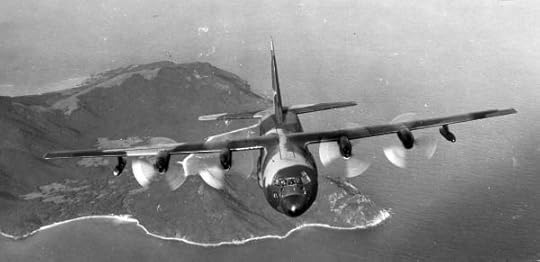 John Heimburger flying a C-130 over Okinawa
John Heimburger flying a C-130 over OkinawaJohn graduated near the very top of his class from flight training, so the Air Force allowed him to choose the type of aircraft he would fly operationally. John picked the C-130 “Hercules”, a rugged 4-engine turboprop transport plane designed to move and supply troops on short runways at or near the battlefield. He chose C-130’s because he thought they would give him the best chance of getting into the Vietnam War—he was right! After completing his C-130 advanced pilot training at Sewart Air Force Base in Tennessee, he reported to the 35th Troop Carrier Squadron at Naha Air Base on Okinawa, arriving on December 31st, 1964. Shortly after arriving, he was presented with a certificate for being the #1 graduate from his C-130 training class at Sewart.
On January 1st, 1965, just 24 hours after arriving at Naha, John received a call at his quarters—it was time for his first mission. He reported to the squadron, got the C-130 ready, and lowered its cargo ramp. A black limousine approached and drove up the ramp until it was on board the plane. The cargo doors closed and the plane took off for Cambodia. After they landed, they opened the cargo doors and the car drove off.
The plane taxied near some woods to wait for the car’s return. Soon, a horde of people descended upon the crew seeking to sell them everything from food to souvenirs. One man approached John with a handful of stones. John found one that looked like a gray star sapphire that would fit his Air Force Academy ring exactly. He asked the man the price and the man answered $300. John told him he only had $37 (which was true), so the man left. A little later, he came back and dropped the price to $200, which John still could not pay. He came back a third time, only to get the same answer. When the limousine finally returned to the plane, the man came running back and sold John the stone for $37. Later in Tokyo, John replaced the original stone in his Academy ring with the gray star sapphire he acquired in Cambodia. He treats the stone with special respect, assuming that since it was an exact match for his Academy ring, it must have been recovered from an American serviceman killed in the war. It is one of John’s most treasured possessions.
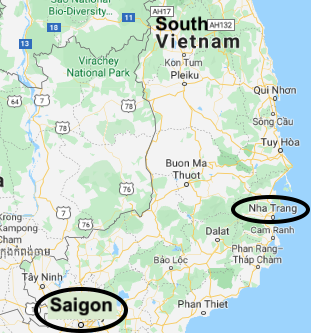 Map of South Vietnam showing Saigon and Nha Trang
Map of South Vietnam showing Saigon and Nha TrangJohn flew his initial C-130 missions as copilot, helping qualify him to fly later as the aircraft commander. That opportunity came on a mission hauling sandbags from Saigon to Da Lat, which was up in the mountains. John recalls there was extremely limited visibility and is certain that had it not been for the skill of his navigator, they would have abandoned the mission. Instead, they broke through the clouds a mile from the runway and made a routine landing on what had been a perilous flight. From this point on, John would fly as an aircraft commander.
Bad weather wasn’t the only thing trying to kill John. On June 24th, 1965, John and his aircrew ate dinner at a floating restaurant on the Saigon river in Saigon. The next day, Viet Cong guerrillas blew up the restaurant, killing scores of people, including 12 Americans. John felt like that summarized his entire time in Vietnam—he was always just one step ahead of disaster.
By the latter part of 1966, the Air Force had lost so many pilots within South Vietnam proper that it held a lottery at Naha Air Base to recruit more. The pilots in John’s squadron were considered eligible for the lottery because, although they routinely flew dangerous missions in Vietnam, they were not permanently assigned there. For example, John’s typical mission schedule would be to fly to South Vietnam and stay in country for 10 days, flying up to 5 missions each day. He would then return to Okinawa for a week, where his wife and newborn son were waiting for him, until it was time to begin the cycle again. Pilots selected in the lottery would transfer to Vietnam and remain there until their tour of duty ended.
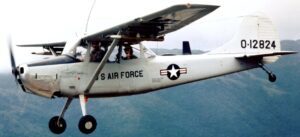 Cessna Bird Dog in flight over Vietnam
Cessna Bird Dog in flight over VietnamThe names of the approximately 440 C-130 pilots on Okinawa were put into a hat and 20 names were drawn. John was one of the 20 and because he was junior in rank, he was assigned to fly as a forward air controller, or FAC. This job was extremely dangerous because it involved flying a very slow single-engine Cessna O-1 “Bird Dog” over the jungle, identifying and marking enemy positions with smoke rockets, calling in tactical airpower to attack the target, and then flying over the target again to assess and report the damage. Later, a slightly faster plane, the 2-engine Cessna Skymaster was used, but the missions were still incredibly dangerous as evidenced by the need to replace the many pilots killed in the war.
Having “won” the lottery, John reported to Eglin Air Force Base in Florida to learn to operate as a FAC. After completing his training, his next stop was Nha Trang, South Vietnam, where he flew missions primarily in the III Corps area of responsibility in the vicinity of Cam Ranh Bay. He roomed with field surgeons from the 8th Army, who liked having him around because he had his own jeep and could take them to the beach when they had free time. In return, the surgeons let John scrub up and taught him to be a surgical technician in the operating room. The experience helped John land a job years later on the faculty of the Johns Hopkins School of Public Health in Baltimore.
During one such surgical assistance session, a badly burned FAC pilot was brought in. John knew the officer from the Air Force Academy, although he was a couple of years ahead of John. His burns were severe and he could not talk, but John spent a lot of time with him, talking to him even though he could not respond. Being too weak to move, the officer could not be evacuated to a hospital better equipped to treat him. Finally, some new burn ointment arrived from Texas and the injured officer improved enough to be transferred stateside. He silently saluted John before he departed, even though John was the junior officer. Miraculously, the injured officer survived the war and John reconnected with him many years later.
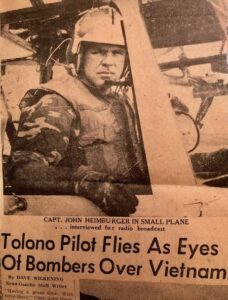 News-Gazette story about John Heimburger in Vietnam
News-Gazette story about John Heimburger in VietnamDuring one FAC mission out of Nha Trang, John took a hometown reporter along to see what flying low and slow in search of the enemy was like. During the flight, the reporter noticed a line running up the side of a mountain and pointing north. John flew down to take a closer look, snapping some pictures with a black and white Polaroid camera and reporting what now appeared to be several parallel and lateral open areas on the side of the mountain. A special forces team later reconnoitered the site and discovered it was a North Vietnamese radio antenna, likely used to report on U.S. military activities in the III Corps area. Strike missions were ordered and the antenna was destroyed. The Champaign-Urbana Courier, the News Gazette, and WLRW Radio all covered the story, making sure the people of Tolono knew what their hometown hero was doing in the war.
John was also exposed to Agent Orange during his time as a FAC. During “defoliant” missions, 3 C-123 twin-engine “Provider” aircraft would fly in a tight formation low over the jungle spraying Agent Orange. John flew above the formation watching for enemy fire, ploughing through the Agent Orange mist floating above the spraying aircraft. John is certain some of his health issues are Agent Orange related.
Around October of 1967, John was reassigned to the Marine fortress at Khe Sanh. The base was under constant attack by the North Vietnamese, who were determined to replicate their 1954 victory over the French by surrounding and defeating the Marines. The Marines, however, held their ground. John flew his Bird Dog from the Khe Sanh airfield, helping detect any positions and calling in supporting fires.
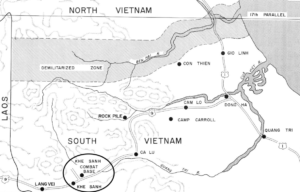 Khe Sanh near the DMZ between South and North Vietnam (Source: U.S. Army)
Khe Sanh near the DMZ between South and North Vietnam (Source: U.S. Army)During one such mission just before Christmas in 1967, John was called upon to assist two F-4 aircrew shot down near Tchepone Pass, Laos. Armed only with an M14 rifle, a revolver, and smoke rockets, and taking small arms fire from North Vietnamese forces, John held off the enemy and provided cover for one of the downed aircrew as he moved from bomb crater to bomb crater up the side of a mountain. With John flying low overhead in his Cessna Bird Dog, the aviator made it to a point where an unarmed Marine helicopter could rescue him. After refueling in Khe Sanh, John returned to the scene of the F-4 crash to search for the other aviator, all the time taking fire from the North Vietnamese. Unfortunately, the second aviator did not survive the crash. For his bravery under fire and disregard for his own life, John was awarded the Silver Star, our military’s third highest award for valor in combat.
In December of 1967, bad weather around Khe Sanh forced John to land at Nkhon Phanom Air Base in Thailand. He arrived just in time to see the Bob Hope Christmas Show. Even better, because John knew the officer in charge of the Officers Club, he attended a buffet with Bob Hope, Raquel Welch, Barbara McNair, Miss World, and other cast members after the show. This was the second of three times John would meet Bob Hope during his Air Force career.
As the North Vietnamese lay siege to Khe Sahn at the beginning of 1968, the mortar, artillery and rocket attacks intensified and small arms fire increased. John continued to operate from the base, flying FAC missions and watching as B-52s dropped tons of high explosives on the enemy forces hiding in the jungle. When John flew too close to the B-52s’ targets, the shock waves from the bombs buffeted his Cessna through the air.
Despite the incessant bombing and supporting artillery fire from U.S. forces, the North Vietnamese pressed their attack until it became too dangerous for John to operate from Khe Sanh’s airstrip. He was directed to leave, but continued to fly from Khe Sanh for two additional weeks. Finally, he was told that if he enjoyed being an Air Force captain, he needed to get out of Khe Sanh and operate from Da Nang. The Marines defending Khe Sanh displayed their admiration for him when he finally left by designating him as an honorary Marine. They also held on to Khe Sanh until the North Vietnamese siege broke. The Marines pulled out of Khe Sanh in June of 1968 and the base officially closed in July.
John left Vietnam and returned to the United States in the latter half of 1968. He had been designated for the Skylab astronaut program, but his entry into the program was delayed. Instead, he reported to Hurlburt Field on Eglin Air Force base for 6 months duty as a FAC instructor, helping train pilots to do what he had done so successfully for the past year. At the end of the 6 months, the Air Force again delayed John’s entry into test pilot school at Edwards Air Force Base in California and continued him as a FAC instructor in Florida. Six months later, the same thing happened. When the Air Force sought to delay him a fourth time, John decided to return to civilian life, having accrued enough time on active duty to do so. Still, he continued to serve in the Air Force Reserve and Air National Guard in Utah, Maryland and Colorado. He retired in 1986 as a Lieutenant Colonel having flown 665 combat missions. He was awarded the Silver Star, 2 Distinguished Flying Crosses, the Bronze Star, 26 Air Medals, and the Vietnam Cross of Gallantry.
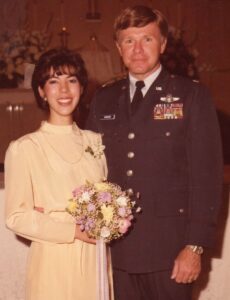 John and Chris at their wedding
John and Chris at their weddingJohn’s civilian life is every bit as extraordinary as his military career. After the Air Force, he obtained his MBA from the University of Utah in Salt Lake City, graduating in 1972. He spent the next 4 years on the faculty of Johns Hopkins University before accepting the invitation of a friend to fly for Frontier Airlines, which later merged with Continental Airlines. He formally retired from Continental when he reached the mandatory retirement age of 60, having amassed nearly 31,000 flying hours. He’s an active member of the Veterans of Foreign Wars and an ardent supporter of U.S. servicemembers. Finally, after his first marriage ended amicably, John married his wife Chris, who has stood by his side now for over 38 years.
No story about John would be complete without mentioning the impact of Scouting on his life. John and his best friend, Lin Warfel, joined Cub Scouts as young boys. Lin’s mother, Adeline, was their Den Mother. Adeline lost her husband on the beaches of Normandy during World War II and was like family to John. John credits Scouting with reinforcing the values his parents taught him, allowing him to be successful in life. John has tried to pay that back to Scouting, working with Boy Scouts and leading trips to exciting places around the United States, helping mold young men into solid citizens. John’s influence worked best at home, though, with three of his sons becoming Eagle Scouts.
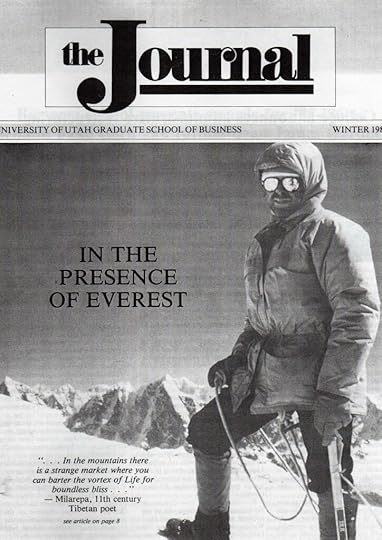 John Heimburger on the summit of Imje Tse near Mount Everest
John Heimburger on the summit of Imje Tse near Mount EverestAn outgrowth of Scouting is John’s love for the outdoors. He remembers as a boy marveling at the news Sir Edmund Hillary and Tensing Norgay had successfully reached the summit of Mt. Everest in 1953. He climbed to the top of the highest tree in his backyard and thought to himself that someday he, too, would climb that mountain. Never losing sight of his dream, John pioneered an adventure program at Frontier Airlines and, together with other Frontier and Continental Airlines employees, climbed mountains around the world, including in the Alps and the Andes, as well as Mount Fuji in Japan and Mount Kilimanjaro in Africa. Their initial climb was to the summit of Island Peak, also known as Imje Tse, near Mount Everest in the Himalayas. There, without oxygen, John and one other of the 8 Frontier Airlines employees on the expedition reached the 20,350 foot summit!
Although it has been a long time since John marched across the Air Force Academy campus, he still has a strong bond with his graduating class. At their 50th reunion in 2013, John made sure the program included a tribute to their wives in the Air Force Academy Chapel. John wants everyone to understand the crucial role military spouses play in supporting our armed forces. While servicemembers are deployed around the globe in harm’s way, it’s military spouses who hold their families together amid the reality that they may never see their loved ones again. The 700 people attending the tribute wholeheartedly agreed!
Words will never be enough to thank Lieutenant Colonel Heimburger for his many years of selfless service to the United States. Through his example during times of war and times of peace, he has embodied all that is good about America. He’s taught countless young men and women to see challenges as opportunities rather than barriers, and reinforced that the United States is the land of the free and the home of the brave. Voices to Veterans proudly salutes Lieutenant Colonel Heimburger for all he has done for our country. We wish him fair winds and following seas.
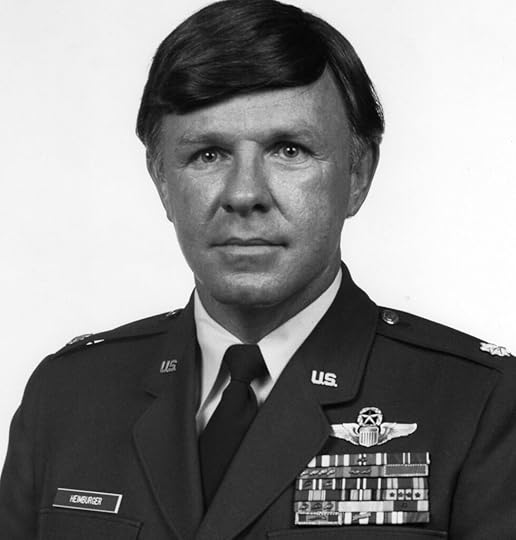 Lt. Col. John W. Heimburger, U.S. Air Force
Lt. Col. John W. Heimburger, U.S. Air Force
November 2, 2019
Petty Officer Second Class Arnold Fernandes, U.S. Coast Guard – From the Aleutian Islands in World War II to the Korean War
The bravery of the men and women in the United States Coast Guard is legendary. They set sail in the most hazardous weather conditions to rescue mariners and migrants at sea and to interdict smugglers trying to bring illegal drugs to our shores. The Coast Guard is also a military service, with ships and crews in harm’s way taking the fight to the enemy sometimes far from our shores. No story better exemplifies the bravery, heroism, and commitment of the men and women of the Coast Guard than that of Petty Officer Second Class Arnold Fernandes, who served in the Coast Guard during World War II and the Navy during the Korean War. This is his story.
Arnold’s parents immigrated to the United States from Portugal, initially settling in Gloucester, Massachusetts, where Arnold was born in January 1924. Arnold’s father was a commercial fisherman, plying his trade in the unforgiving waters of the north Atlantic until 1926, when he moved the family to the more hospitable environment of southern California. There they settled into the Portuguese fishing community of Point Loma, a beautiful, hilly peninsula bordered on the west by the Pacific Ocean and on the east by San Diego Bay. Arnold lived in Point Loma through his junior year of high school, but moved to Chula Vista in San Diego County for his senior year. He graduated from Sweetwater High School in June of 1941 and enrolled in the fall at San Diego State College.
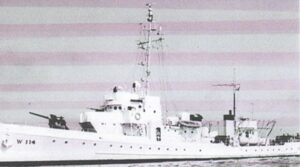 Coast Guard Cutter Perseus (WPC 114)
Coast Guard Cutter Perseus (WPC 114)After a little more than a year of college and with World War II raging in Europe and across the Pacific, Arnold and three of his best friends from San Diego State decided to enlist in the Coast Guard. The Coast Guard was well-respected in the fishing community, and Arnold held it in high esteem. In fact, in the late 1930’s, the Coast Guard saved his father’s life after his father became very ill on his fishing vessel while operating off the coast of Mexico. So, it was only natural that on November 5, 1942, Arnold raised his right hand and answered the Coast Guard call of duty. Without being given uniforms or training, he and his three friends were immediately sent to the Coast Guard Cutter Perseus, which was homeported in San Diego. Arnold became a “sonar striker”, which meant he would be trained to send high-pitched pings through the water using the ship’s sonar equipment. When the pings bounced off the hull of a lurking submarine, he could pinpoint its location and help vector his ship in for attack.
Unfortunately, sonar training wasn’t available on board the Perseus, so Arnold transferred to Naval Station San Diego to attend sonar school. He graduated in early 1943 with the rank of Petty Officer Third Class, and, with a logic only those who have served in the military can appreciate, was detailed to a small patrol boat in San Pedro, California, that had no sonar capability. Instead, he was given quartermaster duties, which meant he was charged with helping to navigate the boat. The boat’s Executive Officer was a famous actor, Henry Wilcoxon, who had leading roles in a number of Cecille B. DeMille films and also starred in movies with the likes of Vivien Leigh and Lawrence Olivier. Arnold remembers Wilcoxon getting a kick out of watching him dive off the ship’s bridge for man overboard drills.
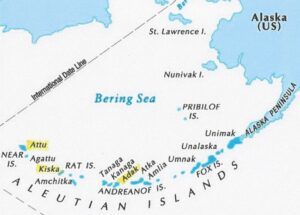 The Aleutian Islands in the northern Pacific Ocean
The Aleutian Islands in the northern Pacific OceanPatrolling off the coast of sunny San Diego in early 1943 was short-lived. After about one month, Arnold transferred to the Coast Guard Cutter Aurora in the Aleutian Islands. In a little known theater of the war, the Japanese had invaded the islands of Attu and Kiska in the Aleutians in June of 1942 as a diversion for their planned invasion of Midway Island, further south. That gave the Japanese bases on U.S. soil from which they could attack U.S. ships and facilities on other islands in the Aleutian chain. Arnold realized this first-hand when he arrived at the U.S. Navy base in Dutch Harbor on Amaknak Island en route to the Aurora. There he saw a repair ship smoldering after being bombed by the Japanese. With the smoke rising over the harbor, Arnold realized for the first time he was in the middle of a war. He continued west to the Navy base on Adak Island, where the Aurora was homeported. This time the ship did have sonar, as its primary duties were anti-submarine patrol, search and rescue, and escort duty.
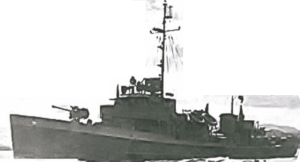 Coast Guard Cutter Aurora (WPC 103)
Coast Guard Cutter Aurora (WPC 103)In May of 1943, the Aurora sailed with the U.S. task force charged with retaking Attu and Kiska Islands from the Japanese. The U.S. landed troops on Attu Island on May 11, 1943, without adequate equipment and under horrible weather conditions. The operation culminated on May 29th, when the Japanese commander led one of the largest Banzai attacks of the war against the unsuspecting Americans, breaking through the American lines and into the rear echelon. The attack was subsequently beaten back with heavy losses and complete annihilation of the Japanese attackers—only 28 enlisted men survived out of a force of around 2500. The U.S. suffered nearly 4,000 casualties retaking Attu, including 549 killed in action. The invasion is seared in Arnold’s memory.
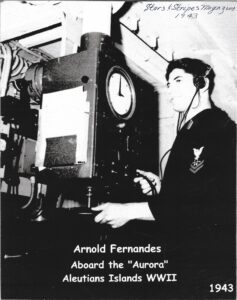 Arnold operating sonar onboard the Aurora in 1943. The photo appeared in Stars & Stripes magazine.
Arnold operating sonar onboard the Aurora in 1943. The photo appeared in Stars & Stripes magazine.Several other events stand out for Arnold in 1943. On one occasion when the Aurora was patrolling off Attu Island, Arnold was serving as the duty sonarman and made a definite contact with what he believes was a Japanese 2-man submarine trying to position itself to torpedo the Aurora. The Aurora went to general quarters and the crew manned all the ship’s guns. The ship also dropped depth charges and fired hedge hogs, and eventually the hedge hogs scored a hit, exploding when one made contact with the submarine. Although Arnold does not believe the engagement was recorded in the ship’s log, he is certain of both the contact and the resulting hit.
On another occasion, the Aurora rescued the crew of a downed PBY-Catalina patrol aircraft. The plane’s crew was laying on the wing, half-frozen in the frigid weather off the Aleutians. Then, on July 19, 1943, the Aurora was called upon to rescue the crew of the cable laying ship Dellwood, which had struck a rock while laying cable between Dutch Harbor and the outlying Aleutian Islands. The Aurora saved the crew without loss of life, but the Dellwood sank in Massacre Bay, the site of the U.S. Army’s landings on Attu Island.
Arnold’s most harrowing experience occurred on December 11, 1943, when the Aurora and the other ships in Task Force 8.6 were ordered to return to Adak Harbor to seek shelter from a mammoth storm heading toward them with 200 mile-per-hour wind gusts. On the way to the harbor, the Aurora’s starboard side started to ice up and the ship began to list from the weight. With the wind and waves tossing the 165-foot vessel to and fro, crewmembers went onto the main deck and, after securing themselves with safety lines, began to chip away the ice using fire axes. Although they were able to clear away a lot of the ice, the seas became so rough that the Captain gave up the effort and ordered all hands below deck. The men were further directed to secure all watertight hatches.
Miraculously, the Aurora made it safely to Adak Harbor with the rest of the fleet, consisting of battleships, cruisers, destroyers, and support ships. However, unlike the rest of the fleet, the Aurora received orders to immediately turn around and search for two missing Liberty ships believed to have cracked in half with their crews in imminent peril of loss. When the Captain asked if there was time to take on fresh water and fuel, he was told “no, carry out your orders.” The Captain did, again ordering the crew below deck with hatches secured, and the small ship set out into the raging storm.
As the ship made headway, Arnold stood duty in the sonar room located just behind the bridge. It was then that the Captain and the Executive Officer entered the compartment and put the Aurora’s documents into a 2-foot-wide by 3-foot-long by 2-foot-deep brass box with 1-inch holes drilled into it. Arnold hadn’t paid much attention to the brass box before, but now he realized it was designed to make sure the ship’s papers and codes would not float to the surface and be captured by the Japanese in the event the ship sunk. He also realized the Captain’s and Executive Officer’s actions meant they both believed there was a good chance the ship would be lost in the storm.
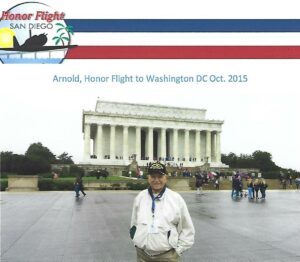 Arnold in front of the Lincoln Memorial as part of an Honor Flight for veterans in 2015
Arnold in front of the Lincoln Memorial as part of an Honor Flight for veterans in 2015The Aurora’s orders were to look for the Liberty ships SS John P. Gaines and SS Chief Washakie. They never found the John P. Gaines because it had actually broken in half and sank on November 24th with the loss of ten crewmembers. As the weather began to subside, they did find the Chief Washaki, a 422-foot Liberty ship built in 1942, with her bow starting to break away just forward of the bridge. Fortunately, the crew was safe and had secured the bow to the hull using chains to keep it from completely breaking away. Given that the Aurora was less than half the size of the Chief Washaki, she was unable tow the damaged vessel to safety. So, with the Chief Washaki crew safely manning the damaged ship, the Aurora stood by until help arrived.
After the Chief Washaki rescue, the Aurora returned to Adak and then sailed to Bremerton Naval Shipyard in Seattle, Washington, to repair the damage it sustained in the storm. The Aurora had lost all of her lifeboats, her decks were warped, and the ship’s 3-inch guns were torn loose from their deck mounts. Arnold and his fellow crewmembers do not know how the ship stayed afloat, but they thanked God for her seaworthiness. In fact, one of the crewmembers wrote a poem about the resilient little ship: “The Aurora is a mighty ship we call the ‘A’. She doesn’t run on steam, she doesn’t run on hay. She just bobs around like a cork, that’s what we like about the ‘A’”. Another shipmate wrote on a Christmas menu: “After two years in the Aleutians there’s one thing we can tell, when we die we’ll go to heaven ‘cause we served our hitch in hell.”
Arnold did not escape his time on Aurora unscathed. During a storm, he fell down two decks and severely injured his tailbone. He was transferred to the Naval Hospital on Adak where he underwent three surgeries. After recuperating for one month, he was sent back to the Aurora, and then to Seattle, where he underwent yet another surgery and further rehabilitation. When he was finally released, he was given orders to the Coast Guard Education Office in Seattle, where he replaced a Chief Petty Officer being discharged. His duties involved checking in movie projectors from ships returning from duty and showing war documentaries to the Admiral and his staff.
Arnold was discharged from the Coast Guard on January 11, 1946. His father had become very ill from cancer, so Arnold hurried home to be with him. He did not make it in time—his father died while Arnold was on his way home from Seattle.
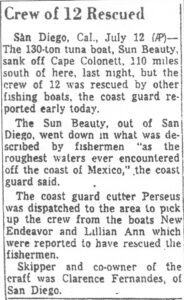 Newspaper article describing the sinking of the Sun Beauty
Newspaper article describing the sinking of the Sun BeautyAfter the war, Arnold tried his hand at several jobs, including working on his brother’s 100-foot, 130-ton tuna fishing boat, the Sun Beauty, out of San Diego. On July 10, 1947, Arnold, his brother Clarence, and ten other crewmembers set sail from San Diego headed for the tropical eastern Pacific in search of tuna. Early on the morning of the 11th after Arnold had come off watch and bedded down, the ship began to roll in the heavy seas preceding a coming storm. One roll was so severe, it wedged Arnold against the starboard side of his bunk and the ship did not right itself. He roused the navigator sleeping below him and said the ship was about to capsize. They scurried out of the compartment just as water began to rush in.
When Arnold and the navigator climbed out onto the main deck, they found Clarence telling the crew to remain calm. He warned them not to jump into the water as they would likely never be found. Instead, after accounting for the entire crew, Clarence directed them to climb into the fishing net tender skiff, which was still seaworthy, before the Sun Beauty sank. For some unknown reason, Arnold salvaged a bottle of Seagram’s VO and a can of asparagus, but essentially everything else in the Sun Beauty was lost. Arnold can still picture the stern of the ship sinking below the waves, with the words Sun Beauty and San Diego visible until the very end. It only took fifteen minutes for the Sun Beauty to go down.
Clarence headed the skiff in the direction of the coast, but it was so slow and the seas so rough that there was no way they could outrun nightfall and the impending storm. They saw a couple of tuna boats on the horizon heading for the port of Punta Colonet in Baja California, but they could not attract their attention. Around 5:00 p.m., they spotted another boat heading toward Punta Colonet. Realizing this might be their last chance, Arnold picked up the can of asparagus, polished the top of it, and used it to flash an “SOS” in Morse code by reflecting the setting sun’s rays. Unbelievably, it worked, and the small boat turned in their direction. When the boat reached the skiff, its two-man crew threw a line to the skiff and towed it to Punta Colonet. The Sun Beauty’s crew was saved by Arnold’s quick thinking and a can of asparagus!
The next day, the Coast Guard Cutter Perseus, Arnold’s very first ship, arrived in Punta Colonet to take the crew of the Sun Beauty back to San Diego. The Perseus gave them each food and water and a pair of jeans and a t-shirt so they wouldn’t have to land in San Diego in their shorts. It’s hard to imagine, but Arnold had survived two years in the icy, war-ravaged waters around the Aleutian Islands only to almost be killed off Baja California’s sunny coast. It didn’t stop Arnold and his brother, though, as two weeks later they had a new boat, the Sea Wolf, and were sailing back to the eastern Pacific in search of Tuna.
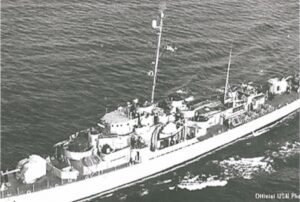 Destroyer Escort Walton (DE 361)
Destroyer Escort Walton (DE 361)Arnold also was active in the Navy Reserve after the war, and he was recalled to active duty in the Navy as a Second Class Petty Officer from August 28, 1950, to February 1, 1952. This time he served as a sonar operator on the Destroyer Escort USS Walton, operating off the coast of California training submarines and sonar teams, and performing escort and other duties as assigned. He was formally discharged from the U.S. Naval Reserve on July 31st, 1953.
After the Korean War, Arnold returned to the family business, working on Clarence’s commercial tuna fishing boat. He eventually transitioned to the Van Camp Sea Food Company as the Fleet Operations Manager, and retired in 1980 from Bumble Bee Sea Foods.
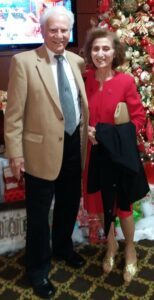 Arnold and Anna
Arnold and AnnaArnold moved to Cardiff by the Sea in 1979, where he served as a director on the Cardiff Town Council. He is a life member of the Cardiff Chamber of Commerce, the Cardiff Town Council, and the Friends of the Cardiff by the Sea Library. As if that wasn’t enough, he is active in American Legion Post 416 in Encinitas, California. Arnold still lives in Cardiff by the Sea with his wonderful wife, Anna.
Voices to Veterans is proud to salute Petty Officer Second Class Arnold Fernandes for his selfless service to our country in the Coast Guard and the Navy. He served with distinction in the unforgiving waters of the northern Pacific around the Aleutian Islands, knowing that every voyage could be his last and risking his life to rescue others from the perils of the sea. Even when he returned to civilian life, he continued to serve his community through both business and government. Arnold, we thank you for all you have done defending our freedom, and we wish you fair winds and following seas!
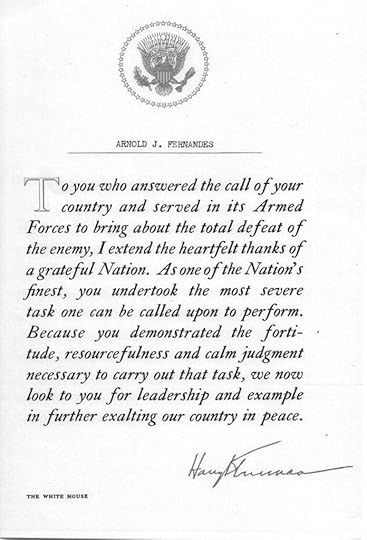 Thank you letter to Arnold Fernandes from President Harry Truman
Thank you letter to Arnold Fernandes from President Harry Truman
October 3, 2019
Staff Sergeant Adam Joseph, U.S. Army – Two Tours In Vietnam Says It All
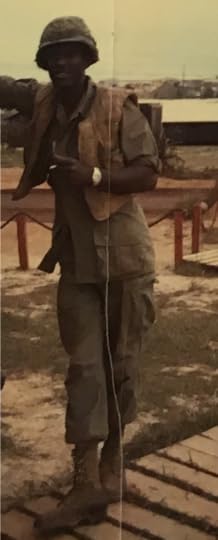 Adam Joseph in Vietnam
Adam Joseph in VietnamStaff Sergeant Adam Joseph has seen a lot in his life. He’s survived two tours in Vietnam and Hurricane Katrina. He weathered both storms with a strong sense of family, a total commitment to his fellow soldiers, and an unwavering faith in God. I’ve spoken to some of the men he served with and they are inspired by his example. This is his story.
Adam was born and grew up in New Orleans, Louisiana. He was the second oldest in a family of 8 sisters and 5 brothers and the son of a Navy veteran. While his family was very poor, his mother and father instilled in all of them the importance of family and strong moral values. They also taught Adam the value of hard work, and after graduating from George Washington Carver High School in 1965, he began working in a shipyard learning to be a welder. However, because he had just turned 18 before he graduated, he was soon invited to join the Army by his local draft board.
As a new draftee, Adam reported to the Customs House in the heart of New Orleans around May of 1966 to fill out paperwork and get his Army physical. After saying goodbye to his mother and father, he and the other Army draftees were loaded onto a bus and taken to Basic Training at Fort Polk, Louisiana, about 4 hours away.
Basic Training lasted 8 weeks under the intense Louisiana summer sun, but it didn’t bother Adam because he was used to the heat and humidity having grown up in New Orleans. As a result, he got through the training without much difficulty because he did what he needed to do to get through. Not everyone had the same cooperative attitude. Adam remembers one big guy who had been a top wrestler in high school and was always giving the drill sergeant a hard time. The drill sergeant was a small man, so the recruit thought he could intimidate him into allowing him to slack off. At one point, the recruit outright told the drill sergeant he wasn’t going to do what he’d just been instructed to do. The drill sergeant took off his hat and the recruit took a swing. Moments later the drill sergeant had the recruit begging to let him go. The drill sergeant didn’t hurt the recruit, but he made it clear from that point on, he was not to be messed with—and no one did.
After graduating from Basic Training, Adam headed to Fort Sill, Oklahoma, for Advanced Individual Training (AIT) in artillery. He trained on the 155-millimeter self-propelled howitzer, where he learned to fire the big gun on the ranges in central Oklahoma. After Fort Sill, he returned to Fort Polk for Tiger Land training, which was training specifically tailored to prepare soldiers for combat in Vietnam. Adam spent 6 weeks at Tiger Land learning how to fight and survive in the jungle. The training included live weapons firing, identifying and avoiding trip wires and booby traps, evading capture, avoiding poisonous snakes, and jungle survival skills. After Tiger Land, Adam returned to Fort Sill for additional training on the 155-millimeter self-propelled howitzers. Once he completed that training, he was off to Vietnam.
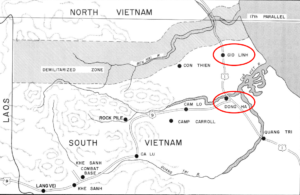 The DMZ between South and North Vietnam
The DMZ between South and North VietnamIn July of 1967, Adam departed for Vietnam from the West Coast together with a plane load of other replacement soldiers. They flew on a chartered jet, complete with stewardesses, to Cam Ranh Bay in the Republic of South Vietnam. After the long trip, the soldiers were happy to get off the plane and were hugging the stewardesses goodbye, but as Adam departed on the tarmac, he saw the caskets of fallen American servicemen waiting to be loaded on an outgoing plane. It was a somber reminder that the Vietnam War was deadly serious.
Cam Ranh Bay was a major staging area for new arrivals, so Adam didn’t stay their long. He boarded a C-130 cargo transport aircraft and flew north about 2 hours to Dong Ha in the vicinity of the demilitarized zone (DMZ) between South and North Vietnam. From there he and 2 other replacement soldiers boarded a Huey helicopter gunship for the final leg of the trip to his unit at Gio Linh, which is just to the south of the DMZ on Highway 1. That highway runs all along the Pacific coast of South Vietnam, from the DMZ to Saigon.
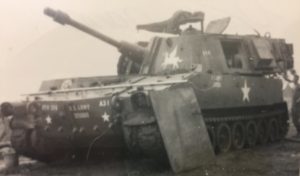 M108 105-millimeter howitzer
M108 105-millimeter howitzerAdam’s unit was Charlie Battery of the 1st Battalion of the 40th Field Artillery (1st/40th). The battery consisted of 6 self-propelled M-108 105-millimeter howitzers, each of which could fire a 33-pound explosive projectile up to 7 miles. The men of Charlie Battery were happy to see the 3 replacements arrive, because it meant 3 members of the unit whose tours of duty were up could finally go home.
A lesson Adam quickly learned was that everyone in the unit pulled together and looked out for one another. It didn’t matter who you were or where you came from because everyone was in it together. In particular, Adam remembers soldiers making sure those posted on guard duty at night didn’t fall asleep because if they did, the North Vietnamese would infiltrate their position and turn the defensive claymore mines around so that they faced the U.S. firebase rather than facing the North Vietnamese positions. Then, when the enemy attacked the base and the U.S. defenders set off the mines, they would fire shrapnel at U.S. soldiers rather than the attacking enemy.
Adam also relays that the men had various ways of coping with the stress of coming under enemy fire on a daily basis for their entire yearlong tour. He said you just had to learn to deal with it, it was as simple as that. It’s not something you can explain to someone how to do—you just have to do it on your own. Some people turned to alcohol and others to drugs, but everyone had to come to terms with the fact that they might die at any moment. In fact, Adam saw men get killed nearly at the end of their tours when they were looking forward most to going home. The aftermath of the stress stayed with Adam long after he returned from the war.
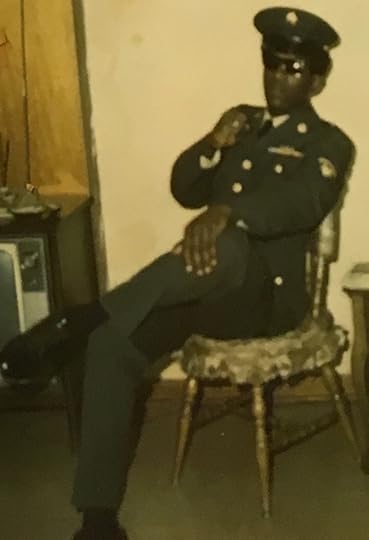 Adam Joseph relaxing
Adam Joseph relaxingAdam completed his tour with the 1st/40th in July of 1968. He originally intended on getting out of the Army, but as he was now a sergeant and had made it through Vietnam, he decided to reenlist in return for orders to Germany. The Army was more than willing to oblige, so Adam went home to New Orleans on 30 days leave after departing Vietnam and then reported for duty with the 1st Battalion of the 36th Field Artillery (1st/36th) in Wiesbaden, Germany.
Adam really enjoyed his time in Germany, but surprisingly, in February of 1971, he and several other soldiers from his unit were ordered back to Vietnam. Adam soon found himself in the vicinity of Dong Ha firing 155-millimeter self-propelled howitzers—the same guns he’d previously trained on at Fort Sill. This time, though, his gun took a direct hit from an enemy round. One crewmember was killed, one had a serious stomach wound, and Adam was blown out of the unit and had a portion of his jaw shattered. He woke up on a plane heading to the Army Hospital at Camp Zama in Japan where the surgeons reconstructed his jaw. He also was bleeding out of both ears after the blast and suffered significant hearing loss—a condition that affects him to this day.
Unbelievably, Adam’s injuries were not enough for a ticket home, so he returned to Vietnam after his recuperation at Camp Zama. This time, though, he stayed in the rear and was assigned to work in a supply room. He departed Vietnam for the last time on January 14, 1972. He continued to serve in the Army Reserves until he was finally discharged on September 13, 1976.
As is the case for many combat veterans, Adam found transitioning back to civilian life difficult. Not only did he have to fight racial prejudice—one California bar he visited on his way home from Vietnam served his white buddies but refused to serve him because he was black—but he was also very angry and couldn’t escape his memories of the war. He tried working on a police force for a year and a half, but didn’t like it, so he went back to the shipyard and ultimately to working offshore in the oil fields in the Gulf of Mexico.
In late August 2005, Adam and his family fell victim to Hurricane Katrina. His mother and brother, who lived in the hard-hit 9th Ward, had to be rescued from their roof after the levies gave way to the floodwaters. Adam had 3 feet of water in his house, but the worst tragedy was that his baby sister, her husband, and her son were lost in the flood. Adam and his wife, Alice, had to rebuild their lives from scratch.
What ultimately got Adam through Katrina and the painful memories of the Vietnam War was he rediscovered his faith in God and returned to the church. Not just any church, but the church that he and all of his brothers and sisters were baptized and married in—Carver Desire Baptist Church in New Orleans. Now Adam sings in the church choir and serves as a Deacon. He is a firm believer in the power of prayer.
As a result of his wartime service in Vietnam and his tours in Germany, Adam earned a Purple Heart, the Vietnam Service Medal, the Vietnam Campaign Medal, the National Defense Service Medal, the Good Conduct Medal, and 4 overseas service bars.
Voices to Veterans is proud to salute Staff Sergeant Adam Joseph, U.S. Army, for his distinguished wartime service and his bravery under fire. When our nation called, he willingly went into harm’s way, not once, but twice, to help defend our freedom. Now he continues to serve his community through his church. While we can never repay Adam for the sacrifices he made during the Vietnam War, we can extend to him our most sincere thanks for his dedicated and outstanding service in the U.S. Army.
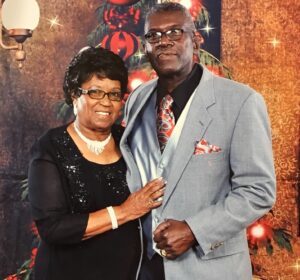 Alice and Adam Joseph today
Alice and Adam Joseph today
September 2, 2019
Private First Class Sue (Van Meter) Hodge, U.S. Army Cold War Service in the Women’s Army Corps
I met Private First Class (PFC) Sue (Van Meter) Hodge after she read an article about when veterans are permitted to salute the American flag. Sue was ecstatic after learning that because she is a veteran, she can salute the flag she so willingly served as a member of the Women’s Army Corps, or WACs, over fifty years ago. Sue is immensely proud of her service and she should be—her service and the service of others like her in the WACs helped pave the way for the many women who serve with distinction in all branches of the U.S. military today. This is her story.
Sue was born in 1944 in Enid, Oklahoma, a small town about 115 miles west of Tulsa. Her father worked as a security guard in the oil and gas industry until he was diagnosed with Tuberculosis. On doctor’s orders, he moved the family to Colorado to recuperate in the fresher climate. They returned to Olive, Oklahoma, when Sue was ten, and that became Sue’s family home. The town was small, with a store, a church, and 8 to 9 houses. Sue and her twin sister graduated from Olive High School, a consolidated school supporting all of the surrounding towns, in May of 1962. Her graduating class had a grand total of 18 seniors, and Sue won the American Legion Medal Award for her class.
There was never a question about what Sue would do after she graduated—she wanted to join the military. All 5 of her older brothers served, with the oldest having fought and been seriously wounded in Europe during World War II. When her brothers came home on leave, they looked very handsome in their uniforms. They also told her about their travel and experiences in the Army and the Air Force, making her want to follow in their footsteps. She was also intensely patriotic and simply wanted to serve.
When Sue was in 9th grade, she told one of her brothers home on leave that she wished women could serve in the military. He said they could and described the WACS, the WAVES (Women Accepted for Volunteer Emergency Service (Navy)), and the WASPs (Women’s Air Force Service Pilots). From that moment on, Sue couldn’t wait to graduate and join the military.
Sue’s brother also told her he would pay her a quarter if she shined his military shoes for him so he would look good in uniform when he went out on the town. Sue said she didn’t know how, so he taught her. He also taught her how to shine his brass belt buckle and buttons, and he paid her for keeping everything clean. This only fueled Sue’s desire to serve.
 PFC Van Meter at Fort Benning, Georgia
PFC Van Meter at Fort Benning, GeorgiaSue didn’t enlist immediately after graduation because it looked like her twin sister might be getting married by the end of the summer, so she waited. By the end of September, though, she was ready. It turns out enlisting in a small town like Olive wasn’t easy in 1962. In fact, the nearest recruiter was in Tulsa, about 40 miles away. The other option was to go to the post office and fill out a card expressing her interest in enlisting, which was the option she chose after she convinced her father that joining the military was the right thing for her to do.
On Tuesday, September 25, 1962, Sue’s father drove her to the Drumright, Oklahoma, post office about 6 miles from where she lived so she could fill out a card. When she informed the clerk about what she wanted, he told her it was her lucky day because there was an Air Force recruiter visiting that day and he’d be back shortly. When he returned, the recruiter said he would pick her up at her house the next day and drive her to Oklahoma City (about 90 miles away) to take her Armed Forces Qualification Test (AFQT) and get her physical. Sue agreed—she was on her way to fulfilling her dream.
When Sue arrived at the Recruiting Office, she filled out the enlistment paperwork, passed her AFQT with flying colors, and took the vision and hearing tests. The recruiter said she scored so high on her AFQT that she could be an electrician. She thought that funny because the only electricity related question on the test asked what AC and DC meant. The results of the vision test were not as funny, though, as her vision in her right eye was impaired and, even though fully correctible, it was disqualifying for the Air Force.
The recruiter didn’t give up on Sue and offered to introduce her to the Navy recruiter. As Sue really didn’t care which service she joined, she agreed to talk with the Navy. She had to fill out the enlistment paperwork and take the same AFQT again, and then took another vision and hearing test. Again she was disqualified because of the vision in her right eye. Like the Air Force before, the Navy recruiter did not give up on Sue and offered to introduce her to the Army. Still determined to get into the military, Sue agreed.
Now with the Army recruiter, Sue again filled out the enlistment paperwork, took the AFQT, and repeated the vision and hearing tests. The Army recruiter commented that she “aced” her AFQT. Sue responded that she ought to have given that she’d taken it 3 times that day and nearly had it memorized. This time, though, the enlistment results were different because the Army was willing to waive Sue’s poor vision in her right eye since it was fully corrected. The recruiter drove her back to Olive and told her he would pick her up on Monday morning so she could finish her physical, sign her enlistment contract, and be sworn into the military.
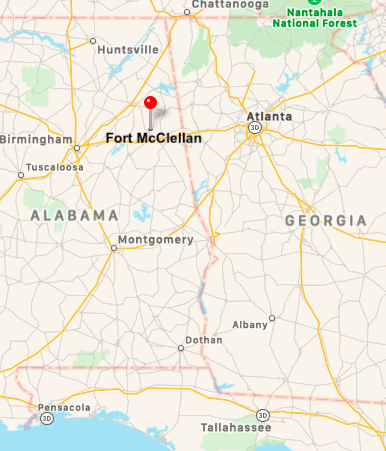 Map showing the location of Fort McClellan, Alabama
Map showing the location of Fort McClellan, AlabamaThe recruiter rang Sue’s doorbell precisely at 5:30 a.m. on Monday morning, October 1st. For a moment, Sue had second thoughts because she hated getting up so early. But she went anyway and before long, she was officially enlisted in the Army and beginning a journey reminiscent of the movie Planes, Trains, and Automobiles. After a series of short flights starting in Oklahoma City and ending in Birmingham, Alabama, she boarded a train to Anniston, Alabama, home of Fort McClellan and the Women’s Army Corps School. Someone in a jeep picked up her and another woman and took them to the base, where they finally arrived around 2:00 a.m., completely exhausted from having both traveled all day.
It turned out that Sue and her newfound friend from Missouri were the first two members of her training platoon to arrive. Platoon Sergeant Torrence came to see them in the morning and said they would hopefully have enough recruits to begin training soon. In the meantime, they were given mops and buckets and assigned cleaning duties every day until the training finally commenced.
Sue was amazed at all of the women in her platoon. Here she was, barely 18 and from a very small town, and soon she had older, more experienced women arriving from big cities like New York, Chicago, Boston, Miami, and Memphis. Sue and the other women filled out lots of paperwork, were issued their uniforms, and met with Sergeant Torrence for the first time as a unit.
Sue expected Sergeant Torrence to yell at them all the time and order them around, but it turned out to be just the opposite. Instead, Sergeant Torrence told the women that they were all sisters and that she would not tolerate profanity. She treated everyone with respect and referred to them as ladies. Sue really looked up to her.
Soon after everyone arrived, they were formed into 12-person squads. Sergeant Torrence picked a squad leader for each squad and an overall platoon leader, who was to be the sergeant’s right-hand man. Each week, new people would be rotated into the leadership positions. On the second week, Sergeant Torrence selected Sue to be the overall platoon leader. When it came time to rotate the following week, Sergeant Torrence announced that Sue, the youngest person in the platoon, would remain in her position for the rest of the training. She’d earned the respect of her fellow recruits and it made her feel proud.
About three weeks into October 1962, Sergeant Torrence summoned Sue and told her to assemble the platoon in thirty minutes. The recruits, now a little over two weeks into their training, sat on bleachers until the platoon sergeant arrived. Sergeant Torrence told them that the President had ordered all bases to go to Code Red and that this was not a drill—it was serious. Effective immediately, they were on lockdown. She told them that the United States had discovered missiles in Cuba and that the missiles could hit the base at any minute. Sue remembers thinking she wished she’d stayed home because she was now too close to Cuba. While she was thinking about the bad situation they were all in, Sergeant Torrence called out “Private Van Meter,” which was Sue’s maiden name. Sue said it so startled her that she almost hit the floor. The sergeant continued, “You watch everything I do, because if something happens to me, you’ve got to do it.”
Having been there not much more than two weeks, Sue had no idea how she would train the other women—she didn’t even know what to do herself. But the platoon sergeant’s announcement and delegation of authority illustrates the state of mind at the time as the United States and the Soviet Union postured on the brink of nuclear war. Mail delivery to the platoon stopped and the recruits were told they could not tell their families how serious the situation was. Tensions ran high until October 28, when the President announced Russia would pull its missiles out of Cuba.
The Cuban Missile Crisis ended, but not before it impacted one recruit in Sue’s platoon personally. The recruit was 35 years old and originally from Cuba. She joined the Army to become a nurse. In the wake of the crisis in Cuba, she was informed that she could no longer be a nurse. Although she was very upset about the decision, she was determined to stay in the Army and serve out her commitment, which she did.
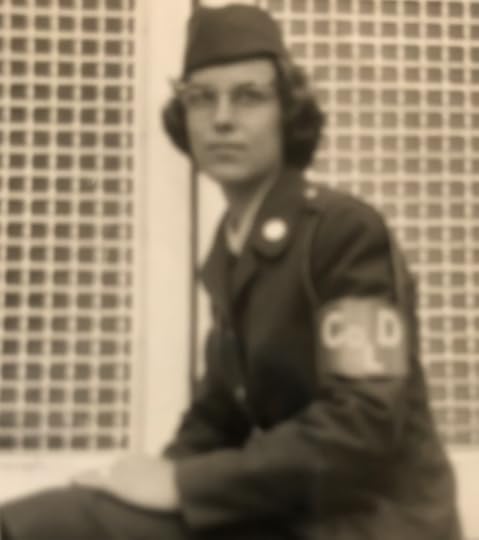 PFC Van Meter before graduation in 1962
PFC Van Meter before graduation in 1962Sue’s platoon graduated on December 7, 1962—Pearl Harbor Day. Immediately after graduation, there was a commemoration for the event, which Sue found very moving. She graduated as a Private (E-2), making $65/month, and had the highest academic scores for her platoon. She was also in good physical shape when she arrived, so the physical training was not a problem for her either. All in all, with one exception, her training experience at Fort McClellan was a positive experience.
Unfortunately, the exception is significant. Not only was Fort McClellan the home of the WACs School, but it was also the home of the Army Chemical Center and School. At the time, Sue didn’t know it was there, but she does now because she was potentially exposed to chemical contamination. Although the Veterans Administration asserts there are no adverse health conditions associated with service at Fort McClellan, many servicemembers and their families disagree. Sue herself has noticed adverse effects that cannot be explained by her family history. Fort McClellan was shut down in 1999 based upon the recommendation of the Base Realignment and Closure Commission. Efforts to create a national registry of military persons potentially exposed to chemical contamination at Fort McClellan have so far proven unsuccessful.
After graduating from WAC School, Sue took 10 days leave at home and then had to report to Fort Benning, Georgia, right before Christmas in 1962. After barely making it in before her leave expired due a flight cancellation, Sue had little to do once she arrived because everyone else was on leave for the holidays. Eventually, she was assigned as a typist in the Adjutant General’s Corps, where she worked typing orders for graduates from Officer Candidate School, as well as for some non-commissioned officers (NCOs). She worked in a large bay area with lots of other Army and civilian workers processing paperwork. The room had windows near the ceiling and Sue remembers watching soldiers doing parachute training as they learned to jump from towers outside her building.
Most of the orders Sue typed were for new officers heading to Germany, Korea, and bases in the United States. After she’d been working 2-3 days, she typed orders for someone going to Vietnam. As she had not heard of it before, she asked her civilian boss where it was and what was going on there. He told her the soldiers being sent there were “advisors” and that he thought something might happen there in the not-to-distant future. After that, Sue typed up orders for someone to go to Vietnam about once each week. The numbers gradually increased until near the end of her assignment in 1964 when she was typing as many as 10-12 sets of orders to Vietnam in a day.
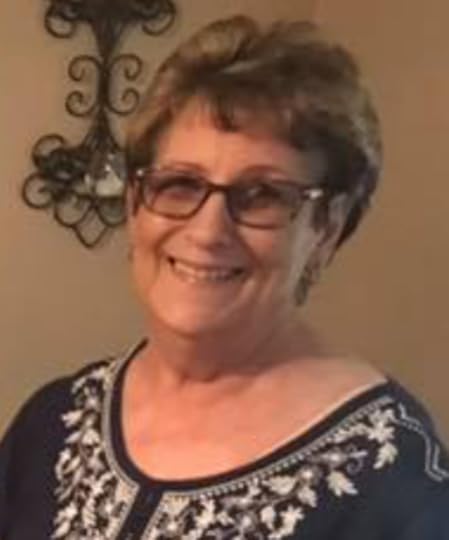 Sue Hodge
Sue HodgeIn March or April of 1963, Sue heard President Kennedy might visit the base. Her unit put on their dress uniforms for the visit, but at the last minute, they heard the President had to send someone else in his place. Sue was disappointed and does not remember who the replacement speaker was—President Kennedy was who she wanted to see.
While Sue was at Fort Benning, she met and married a soldier, and towards the end of 1964, she became pregnant. She didn’t realize that the Army would discharge her if she became pregnant, so she was sad to learn she had to leave the job she loved. Wanting to keep the family together, her then-husband decided not to re-enlist and they all moved back to Olive, Oklahoma.
In the years following the Army, Sue raised her family and had an assortment of jobs, ranging from working in a meat packing factory, to cleaning for the Olive School District, to painting for an interior designer. In 1982, she married Chester Hodge, who passed away after 33 years of marriage in September 2015. She was subsequently reunited with her junior high school sweetheart, Edwin Clark, from Olive School after 60 years. Sue spent 2 years with Edwin, who had served in Vietnam, helping him work through PTSD and other Vietnam-related issues. After losing Edwin, Sue realized how badly the Vietnam War affected so many young men. Now she makes a special effort when she sees Vietnam veterans to shake their hands and thank them for their service. Some smile, some tear up, but all are appreciative.
Sue is proud to say that her oldest son, Randy, also served in the Army and that his first duty station was Fort Benning, just as it was hers. Randy’s daughter, Nicole Boudreaux, now serves in the Air Force and is the third generation of Sue’s family to serve. Sue’s grandson, Steven Hodge, is Senior Vice President of the Oklahoma Chapter of VFW Post 1719 in Chandler, Oklahoma. In total, Sue’s family has over 75 years of honorable service in the U.S. military. Finally, Sue is a Native American citizen, Creek Tribe, of the Five Civilized Tribes of Oklahoma. They take care of their veterans and are a very proud people.
Voices to Veterans is proud to salute PFC Sue (Van Meter) Hodge for her dedicated and patriotic service in the Women’s Army Corps. Sue’s trailblazing service helped pave the way for women who now routinely serve in all branches of the U.S. military, and her willingness to share her story helps preserve the rich heritage of the Women’s Army Corps. Thank you for your service to our country!
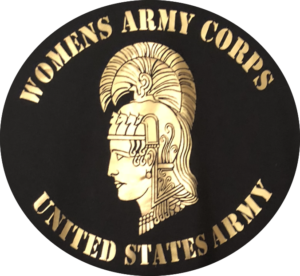 Women’s Army Corps insignia
Women’s Army Corps insignia
July 25, 2019
CSM Thurman C. Cousins, U.S. Army (Retired) Professional Soldier Through to the Core
I’ve had the honor of interviewing numerous veterans. Many were citizen soldiers, drafted in times of national need and answering our nation’s call. When their tours of duty ended, they returned home and got on with their lives. I could tell right away Command Sergeant Major (CSM) Thurman C. Cousins was different. Battle tested in two wars, he was the type of larger-than-life leader who stood firm under fire and spit in death’s eye. His men recognized it too and they instinctively followed him. They succeeded in battle because of his leadership and he helped them come home alive. Yet he is humble and unassuming—the kind of soldier you want to have on your side. This is his story.
Thurman was born in Oklahoma during the depression, the oldest of nine kids. His parents were itinerant workers, sometimes scrounging the already-harvested cotton fields for left-behind cotton bolls and earning a penny a pound. By 1947, his parents had saved enough money to lease a 1400-acre farm in Kaufman County, Texas, about 70 miles southeast of Dallas. Settling down allowed the children to finish school, and in June of 1950, Thurman graduated from Scurry-Rosser High School along with the 7 other members of his class.
Thurman was 17 when he graduated and the youngest in his class. The other boys in his class had already been drafted and Thurman knew he would be too once he turned 18. Rather than wait for his birthday and then have to ship out on his own, Thurman enlisted in the Army on June 16, 1950, and went off to basic training with his friends. Just 9 days later, North Korea invaded South Korea and the Korean War began, sealing Thurman’s destiny.
After completing basic training at Camp Chaffee (now Fort Chaffee), Arkansas, Thurman and the other newly minted soldiers were given 8 days leave to visit their families before they had to report to Oakland, California, to board the fast transport ship USS General M. C. Meigs on their way to Korea via Japan. When the ship arrived in Yokohama, the men were directed off the ship and into a big metal building with Military Police (MPs) posted all around in case anyone had any second thoughts about going to Korea. Once inside, they were issued a duffel bag containing clothing, a back pack, an M1 Garand rifle, and ammunition. Knowing that they would be heading directly into combat, they had to leave most of the clothing behind, taking only spare socks, wool long johns, and a trench coat. They received any necessary last-minute shots, which Thurman remembers being particularly painful. They then loaded on ships and headed for Korea.
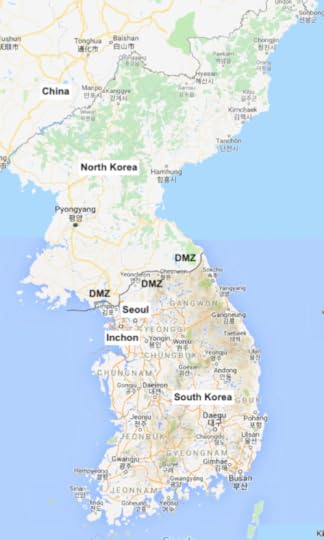 North and South Korea with the DMZ at the border
North and South Korea with the DMZ at the borderThurman and over 5,000 other soldiers aboard the USS General M. C. Meigs sailed to Korea and arrived in late November. They unloaded at the port of Inchon in South Korea, which on September 15, 1950, had been the site of one of Douglas MacArthur’s most brilliant military operations, landing troops behind the invading North Koreans and causing their rapid retreat across the 38th parallel and back deep into North Korea. When Thurman disembarked, he joined the 24th Infantry Division, which by this point was fighting the Chinese roughly in the vicinity of the 38th parallel and the “demilitarized zone” (DMZ) on the border between North and South Korea. Then, on January 1, 1951, half-a-million Chinese soldiers attack the 24th Division and other United Nations forces, driving them south and once again capturing Seoul. Thurman remembers passing through Seoul, which had been reduced to nothing but rubble.
In addition to watching aerial dogfights between U.S. and Chinese fighters overhead, Thurman remembers the bitter cold of the Korean winter. Temperatures fell into the negative double digits, and the soldiers weren’t dressed or equipped to withstand the intense cold. Thurman eventually had to be evacuated to a field hospital because of frostbite. The field hospital tents were a good place to warm up because they were heated by oil burning potbellied stoves. The heat worked for Thurman, as he fully recovered and returned to his unit. Other soldiers weren’t so lucky—their frostbite cost them their fingers and toes.
In February and March of 1951, the 24th Infantry Division help the United Nation’s forces push the Chinese out of Seoul and back across the DMZ into North Korea. Then in April, the 24th and 25th Infantry Divisions were nearly cut off by the Chinese, forcing them again to withdraw. During the retreat, Thurman’s unit dispersed to avoid capture. He remembers climbing a nearby mountain with two other men because they believed from that vantage point, they would be able to better chart their escape route and return to U.S. lines. When they reached the top of the mountain, they found 8 U.S. Air Force airmen running a communications relay station. The airmen shared their rations with the weary soldiers and committed to helping them get back to their unit when they made their next supply run.
When it came time to depart, the soldiers loaded into a three-quarter ton truck driven by the airmen and headed out. Almost at once, the truck hit a landmine, lifting it up and tossing it into a creek bed. Thurman was pinned underneath the truck’s windshield with his head under water, but he was able to work himself free. Miraculously, everyone on the truck survived and they continued on their way, walking 10 miles until they met up with a signal battalion with the 8th Army. They transferred Thurman to the 1st Cavalry Division, who sent him back to Japan, where he was issued clean clothes and new boots and got a few more painful shots for good measure.
Thurman returned to South Korea with the 7th Cavalry and stayed with them for the rest of the war, fighting up and down mountains in the vicinity of the DMZ. The war was largely a stalemate by this time, with the hills around the DMZ repeatedly changing hands between the United Nations and Chinese forces, depending upon who launched the offensive. Finally, on July 27th, 1953, the United Nations and North Korea signed an armistice, with both sides taking up permanent positions along the DMZ near the 38th parallel.
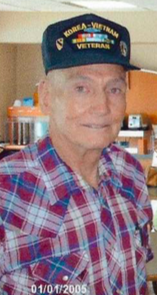 Thurman Cousins in 2005
Thurman Cousins in 2005Thurman was finally able to return home on November 23, 1953. He was initially processed through Japan, but then returned to the United States via ship to Oakland, California, where his journey began three years before. Upon his return, he was issued a new Class A uniform, which looked and felt good, and he headed home to Scurry, Texas, to be with his family.
Although being back with his family was good, Thurman had trouble finding a decent job. He lived in farm and ranch country, so he took the only job available—working as a ranch hand. He worked 7 days a week from 6 a.m. to 10 p.m. for just $2.00 per day. One day he told his mother he couldn’t take it any longer—he was going to reenlist in the Army. A heated argument followed, but the next day, Thurman marched down to the recruiting station and made good on his pledge. He passed his physical the same day and soon found himself on a bus to Fort Hood, Texas, then Fort Bliss, Texas, and finally to a World War II era training camp in New Mexico. He spent 4 years there in barracks so rickety that he had to shake the sand off his blankets every morning and take a bus to Fort Bliss just to wash his clothes.
Then, in February 1957, an opportunity arose that changed the direction of Thurman’s career. The 1st Battalion of the 40th Field Artillery (1st/40th) was being reactivated at Fort Bliss, Texas. Given Thurman’s combat experience in the Korean War, he was offered the chance to help reactivate the unit. During the week at Fort Bliss, he learned to fire the 105-millimeter howitzer. On the weekends, he earned an extra $10/day operating the base switchboard. As his Army pay was only $51/month, the extra $20/weekend was a real boost to his disposable income. A major also gave him some books on artillery and fire direction. He studied the books intensely until he knew them inside and out. He soon knew more about the new unit’s guns than all of his peers and was promoted to Sergeant (E-5).
The 1st/40th was officially reactivated on June 25, 1958. The following year, Thurman was sent to Fort Sill, Oklahoma, for formal artillery training. There he learned to fire the powerful 8-inch M115 howitzer, which could fire a 200-pound projectile almost 10.5 miles. By the end of 10 months, Thurman had become so proficient with the M115 that he could tow it into place with a 5-ton truck and have it set up and firing within 3 minutes. Senior officers took notice, not only at his skill, but also at the pride his soldiers developed in doing their job well. Thurman’s ability to train and motivate his soldiers in this matter would be important throughout the rest of his career.
In the intervening years, Thurman, now married, completed an assignment in France and was stationed at Fort Sill, the home of the Army’s Field Artillery School. Thurman was assigned as a gunnery instructor because of his proven proficiency with the artillery’s big guns. He also bought a house in Lawton, Oklahoma, just outside Fort Sill, where he and his wife, Donna Jean, began raising their three children. They pulled up stakes in April of 1964 to go to West Germany, where Thurman was assigned to the 1st Battalion of the 36th Field Artillery (1st/36th). The unit fielded the M110 8-inch self-propelled howitzer. Given Thurman’s experience, he was promoted to Sergeant First Class (E-7) and he did everything he could to become the best, most proficient soldier possible. The Army made that easy as the training in West Germany was intense, with Thurman spending as much as 10 months out of the year in the field with his unit. West Germany was ground zero for the Cold War with the Soviet Union, so training in Germany was serious business.
In February 1966, a 1-star general from the 7th Army visited Thurman’s unit in a jeep because of the other serious business going on in the world—the Vietnam War. The general announced that the Army needed the unit’s officers and non-commissioned officers (as a First Sergeant, Thurman was a non-commissioned officer, or NCO) for service in Vietnam. Thurman was issued orders and given 7 days to depart Germany with his family and report to Fort Dix, New Jersey. They somehow made it out on time, even arranging for their vehicle to be shipped back to Philadelphia. When they arrived at Fort Dix, they were told report to Fort Hood, Texas, so he loaded his wife and 3 kids, and all of their baggage, onto a bus to Philadelphia to pick up their car. Unbelievably, it had already arrived and they hopped in and drove from Philadelphia to Fort Hood. When they arrived in Fort Hood, they were told to turn around and go to Fort Sill, where Thurman would once again help reactivate the 1st/40th Field Artillery, which had been inactivated since April 1963.
 M108 105-millimeter self-propelled howitzer
M108 105-millimeter self-propelled howitzerAs one of the first NCOs to arrive, Thurman had lots of responsibilities. He was assigned as First Sergeant for Alpha Battery, which had 6 M108 self-propelled 105-millimeter howitzers. These big guns, which had a crew of seven, could fire a 33-pound explosive projectile up to 7 miles. Bravo and Charlie Batteries added 6 more M108s each, for a total battalion firepower of 18 guns. When the 1st/40th had a sufficient skeleton crew of officers and NCOs, a cadre of draftees arrived fresh out of boot camp to man the unit. Thurman took his new soldiers to the west end of Fort Sill and spent the next 8 weeks training them on the M108. He admits he was tough on them, but he taught them everything he knew about the guns and how to be successful in combat.
Thurman cannot say enough about the soldiers he trained during the summer of 1966. He talks about them like a proud parent, noting how dedicated, hard-working and eager they were. He remembers on one evening, allowing them to load into trucks to drive back to Fort Sill for an evening off. He told them he wanted everyone back by midnight. At 11:45 p.m., he heard the trucks returning with all the men singing, apparently feeling good after downing a few 3.2% beers back at the post. The next morning at roll call, he learned they were missing one soldier. The soldier turned up, though, as he’d fallen asleep in the truck on the way back to the training site, so technically he and everyone else was back by midnight.
The 1st/40th finished its training in September 1966 and, after 7 days of leave, started the trip to Vietnam. Since the entire unit and its equipment needed to be deployed, all of the men flew to Oakland, California, where they boarded a ship which already had their M108s loaded onboard. After a brief stop in Okinawa, the ship arrived in Da Nang, South Vietnam, in October 1966. The Navy transferred their M108s to smaller boats that looked like World War II landing craft and convoyed them up the coast to near the demilitarized zone (DMZ) between South and North Vietnam.
Once the M108s were unloaded, Alpha Battery was directed to establish a position on a nearby hill. When they arrived, Thurman told his men to dig positions deep enough so when they lay in them, they would be completely below ground. They finished their work around midnight, which was good because they next night they came under attack from enemy fire from the North Vietnamese side of the DMZ. In fact, during the course of the next year, the three batteries of the 1st/40th were constantly under fire from enemy rockets, mortars, grenades and small arms.
To help fend off the small arms attacks, each battery was issued a 40-millimeter gun to patrol the vicinity around their fire bases. Thurman remembers meeting a staff sergeant in charge of one of those guns. He had 25 years in the Army and was getting ready to retire in 3 months, but was killed on one of the missions. The memory of that staff sergeant has stuck with Thurman all of these years.
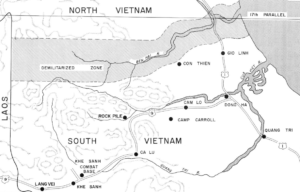 DMZ between North and South Vietnam (Source: U.S. Marine Corps)
DMZ between North and South Vietnam (Source: U.S. Marine Corps)During Thurman’s time with the 1st/40th, the batteries provided fire support for the 3rd Marine Division. They fought in places with names like the Rock Pile, Khe Sanh, and Con Thien. Wherever the Marines went, one of the 1st/40th batteries went with them. The batteries did not fight from the rear—they fought from the front—and as a result, they lost twenty men killed in direct engagements with the enemy.
As the 1st/40th neared one-year in country and many of the unit’s original members had either been lost or rotated back to the States, the unit’s commanding officer, Colonel Lee Roper, asked Thurman to stay on as his Battalion Sergeant Major (the senior enlisted member of the command) until a new sergeant major arrived. Thurman agreed as he had a special bond with Colonel Roper, as they were the only two members of the command who had served in Korea.
One morning, Colonel Roper told Thurman to fill up his jeep with ammunition because they were going to Cam Lo. There were special forces soldiers there and Colonel Roper had promised he would watch out for them. When they arrived, there were no Americans there, as one of the special forces soldiers had been killed and the others had already withdrawn. Sensing they were not in a good place, Thurman manned the machine gun on the back of the jeep with a full belt of ammunition and prepared to fight their way out. He said if a rabbit had jumped out and surprised him, he’d have shot every hair off of it. Fortunately, they made it back to base camp without incident.
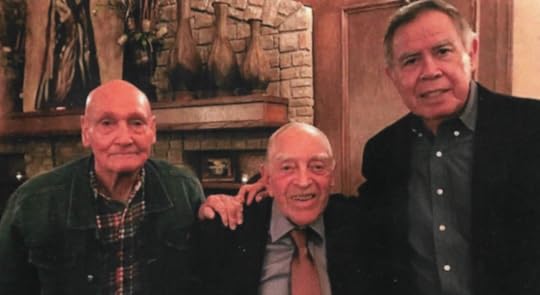 Left to right: CSM Thurman Cousins, COL Lee Roper, and LTC Luis Lopez
Left to right: CSM Thurman Cousins, COL Lee Roper, and LTC Luis LopezIn November 1967, a new Sergeant Major arrived and Thurman was allowed to go home. He also found out he was on the promotion list to Command Sergeant Major, the highest enlisted rank in the Army. His initial assignment was in Fort Sill as the Sergeant Major of the 3rd Corps Field Artillery, but in the summer of 1968, he received orders for his second tour in Vietnam. This time, though, he would serve with the 1st Cavalry Division, which was the unit he’d met up with in Korea after evading capture by the Chinese. Once in country in South Vietnam, he went through a quick jump school, practicing repelling and jumping from a tower with a parachute. He was assigned to Alpha Battery of the 1st Battalion, 77th Field Artillery (1st/77th), firing the lightweight M102 105-millimeter towed howitzer.
The 1st/77th served in the III Corps area of Quan Loi, which is about 60 miles north of Saigon and 10 miles from the Cambodian border. The unit’s mission was to support the 1st Air Cavalry Division. Thurman was involved in combat operations throughout 1969, including fighting the North Vietnamese Army in November 1969 at Tay Ninh, which is right on the border with Cambodia. During that engagement, Thurman’s unit came under an intense nighttime attack, during which Thurman was wounded from the blast of a shotgun. The North Vietnamese soldier paid for the shot with his life, and Thurman confiscated the shotgun and still has it to this day.
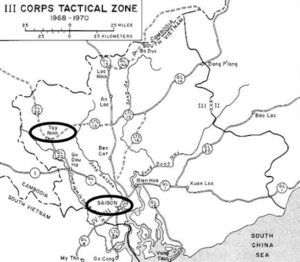 III Corps Tactical Zone around Saigon, South Vietnam (Source: U.S. Army)
III Corps Tactical Zone around Saigon, South Vietnam (Source: U.S. Army)After a brief stint back in Fort Sill from December 1969 to the end of February 1970 while on special leave, Thurman reported back to his unit in Vietnam. In May 1970, Chinook helicopters airlifted the 6 guns of his battery into Cambodia with the 1st Air Cavalry Division. Although they were subjected to constant attacks from the enemy, they captured and destroyed a massive North Vietnamese supply base dubbed “Rock Island East” before pulling back to Vietnam in June. They’d been in Cambodia nearly 60 days, all the time under fire and returning it in kind.
After completing his tour in Vietnam, Thurman returned to Fort Sill, where he again had the opportunity to work with Colonel Roper. He was given responsibility for training 800 soldiers every 8 weeks on the art of field artillery. He did this for 11 months, before transferring to the Arkansas National Guard. Then, in 1973, he was selected to attend the Army’s new Sergeant Major Academy at Fort Bliss, Texas. He completed the course in 6 months and, after a short tour at Cornell University working with ROTC cadets, he transferred to the 10th Special Forces in Italy. This assignment truly was special, as he traveled to Turkey and other countries in the region in civilian clothes supporting nuclear capable Sergeant missiles. Finally, on August 1, 1975, in Fort Sill, Oklahoma, at the age of 42 and after 25 years on active duty, Thurman retired from the U.S. Army.
Now a civilian, Thurman took a position as a major in the Texas Criminal Justice System in Huntsville, a job that allowed him to attend college. He eventually earned his Masters degree and Bachelors degree in 3 subjects, before taking his final assignment as a member of the Texas State Mounted Patrol. After training more than 5,000 people and 4,000 horses in several states, Thurman retired after 22 years. He now lives in his hometown of Scurry, Texas. Although his wife, Donna Jean has since passed away, Thurman is fortunate to have all three of his children living nearby.
Voices to Veterans salutes Command Sergeant Major Thurman C. Cousins, U.S. Army (Retired) for his many years of distinguished service to our country and to the people of the State of Texas. After fighting in two wars and earning 6 Bronze Stars with Vs for valor and countless other decorations, it is time for a grateful nation to say thank you for a job well done. Although we can never repay you for your sacrifices and the sacrifices of your family, we can make sure that your story is never forgotten.
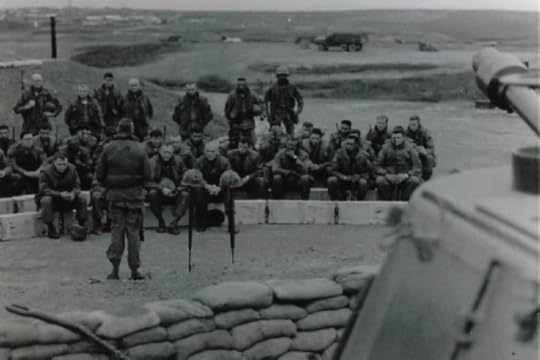 Ceremony for two soldiers from the 1st/40th killed in action in Vietnam during 1966
Ceremony for two soldiers from the 1st/40th killed in action in Vietnam during 1966
May 22, 2019
Sergeant Paul Schuler, U.S. Army – Lifelong Leadership Lessons from Vietnam
Sergeant Paul Schuler, U.S. Army, has an amazing memory. During our three-hour interview, he went from story to story, recalling with great detail his Army experience and his tour of duty in Vietnam. I could tell very quickly the year Paul spent in Vietnam from April 1970 to April 1971 is indelibly inscribed in his identity. His leadership, his work ethic, his relationships, and his sense of duty and honor all relate back to the year a twenty-year-old kid spent serving his country in Vietnam. This is his story.
Paul has deep midwestern roots. He was born and raised in Omaha, Nebraska, where he attended Cathedral High School. After graduating in 1967, he attended the University of Nebraska Omaha, which entitled him to a temporary deferment from the ongoing Vietnam War draft. He also set his sights on becoming an electrician and he joined the local electrician’s union in April 1969. All was going well until the spring of 1969 when Paul decided to change his college major and let the number of hours he was enrolled in fall below the required minimum. The result was a draft notice with a report date of August 11, 1969.
Paul’s report date had special significance because his father was drafted for service in World War II and had a report date of August 11, 1941. Paul’s father landed on the beaches of Normandy on June 9, 1944, and marched with the 30th Infantry Division all the way to Germany. Paul’s father was an Army cook whose favorite story was how he traded vanilla and sugar with the French in return for some ice cream around the Thanksgiving holiday. The men in his unit were so thrilled to get the ice cream, from that point on, Paul’s father could do no wrong. Paul’s father gave him lots of advice about what to do and not do in the Army, all of which Paul tried to follow.
When Paul reported to the Draft Board on August 11, there were about fifty draftees being inducted. As the men lined up, they were asked if anyone wanted to volunteer to serve in the Navy. Hoping to avoid ground combat, over a dozen guys quickly crowded to the front of the room and the required quota was accepted and marched off. Paul thought that odd because the Navy wasn’t part of the draft. In fact, he’d tried to enlist in the Navy Seabees and was told the Navy didn’t need people right now. Then he realized the Marine Corps was part of the Department of the Navy and figured those draftees had unwittingly volunteered to go to the Marines, which was indeed part of the draft. Paul was very happy he had not volunteered.
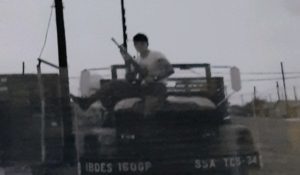 Sergeant Paul Schuler
Sergeant Paul SchulerAfter being sworn in, Paul and the others were flown to Fort Lewis, Washington, for Basic Training. He remembers pulling up to the camp in a bus and hearing a deep, booming voice outside yelling at the trainees to get off the bus. As he stepped off the bus, he looked for the giant barking the orders but was surprised to see a short drill sergeant who could not have weighed more than 130 pounds. Paul must have stared because the drill sergeant asked him “What the hell are you looking at?” Paul hoped he had not already gotten himself on the wrong side of his new boss.
One of the first drills Paul remembers doing was the “low crawl” where he had to crawl on his belly like an alligator through a pit. The first time he did it, the trainee in front of him stopped and Paul thought the drill sergeant would soon be there yelling at the guy to get moving. Instead, the drill sergeant began screaming at Paul, demanding to know why he wasn’t moving. Paul answered that the man in front of him had stopped, to which the drill sergeant replied, “then go over the top of him.” Paul complied, as did a number of other trainees behind him. Paul said the trainee who initially froze in the pit never stopped again.
Paul did well at boot camp. About two weeks into training, he was selected to be his Platoon Guide, to whom four trainee squad leaders reported. This surprised Paul because he’d never been picked to be first for anything before. They asked Paul if he was afraid to take the position. He was but he said he wasn’t, demonstrating for the first time a skill he learned in the Army to tackle problems even if a solution wasn’t immediately apparent. He faced a number of leadership challenges from the men he worked with during his time at boot camp, but he was able to overcome them all. He was even asked to go to Officer Candidate School but declined because his father told him in combat in France, junior officers suffered high casualty rates. He’d also heard about junior officers being threatened or killed by their own men in Vietnam, so it was not something he wanted to do. He also turned down an opportunity to go Airborne, but ended up enlisting for three years instead of his two-year draft obligation in return for attending cable splicing school. Paul thought the school might help his career as an electrician once he returned to civilian life.
Shortly before graduation from Basic Training, Paul bruised his heel on the agility course. Because he’d done well, his drill sergeant took it easy on him, even allowing him to avoid an eleven mile forced march. The drill sergeant told him, though, if he was injured, he would not be allowed to graduate. So, when Paul went to sick call for a progress check on his foot, the doctor asked him how his foot was and he said it was fine. He then walked out of sick call as if nothing was wrong, even though his heel still hurt. He was cleared to graduate on time. Again, his drill sergeant looked out for him and told Paul he did not have to march in graduation. Instead, he could meet up with his unit afterwards at the barracks, which he did.
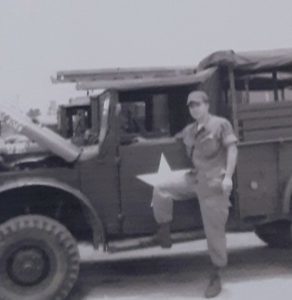 Sergeant Paul Schuler with a truck
Sergeant Paul Schuler with a truckAfter boot camp, now Private (E-2) Paul Schuler flew to Sheppard Air Force Base near Wichita Falls, Texas, for cable splicing school. Again he excelled, despite having a math instructor who seemed to have it out for him because he looked like someone the math instructor got into a fight with in Germany. On the final Friday at the school, Paul was told to report to the orderly room at 4:30 p.m. To his surprise, he was promoted to Private First Class (E-3), but he was directed to get his new rank sewn on his uniform before the bus departed at 5:00. He caught the seamstress at the uniform shop just as she was leaving and convinced her to help him. He made it to the bus on time, now wearing the rank of a Private First Class.
The bus took Paul to Fort Sill, Oklahoma, where he was assigned to the temporary barracks. He stood duty on Saturday night and slept all Sunday. On Monday morning, he was called to see the captain. He tried to think of what he might have done wrong, but couldn’t come up with anything. The captain told him he had graduated first in his class at the Air Force cable splicing school and that any time the Army could take top honors at an Air Force school it was a big deal. The captain meritoriously promoted Paul to Specialist (E-4) on the spot. Having been a Private (E-2) just three days before, Paul considered this a good weekend.
Paul spent little time at Fort Sill. He took two weeks leave to visit his family in Omaha, en route to Vietnam. Paul’s father took him to the airport, where he simply said, “I’ll see you next year.” Paul flew to Oakland, California, and reported to the holding barracks to await his flight to Vietnam. While there, he was able to visit with his aunt and uncle. His uncle took him to the airport and started to cry about Paul going to war. Although Paul appreciated that his uncle was worried about him, he was glad his father had not been emotional because his father and his father’s World War II experience gave him confidence.
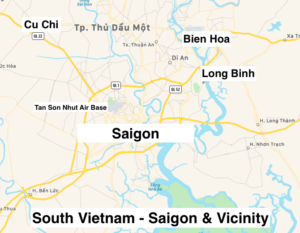
Paul flew to Vietnam on a chartered commercial airplane, with stops in Hawaii, Wake Island, Midway Island, and the Philippines along the way. As the plane arrived over Bien Hoa Air Base near Saigon in South Vietnam, Paul remembers looking out the window and seeing bomb craters around the runways. Suddenly the Vietnam War seemed real. The person sitting next to Paul told him not to worry because those were not all recent craters and that they had accumulated over time. Still, when the plane landed, everyone ran from the plane to the assembly building to minimize their exposure to enemy fire. As they did, they were passed by military personnel running in the opposite direction to board the plane on their way out of Vietnam. Paul vowed when he left Vietnam, he would not run to the airplane.
Because Paul arrived in Vietnam as an individual replacement soldier and not as part of a unit, he was loaded on a bus headed for Long Binh, the Army’s largest base in Vietnam. The bus had a heavy metal mesh covering the windows, which he assumed would prevent a grenade from being thrown inside. The bus driver told the new arrivals if anything happened, hit the floor and don’t look out the windows. The war was becoming more real by the minute.
Once at Long Binh, Paul was taken to the 90th Replacement Battalion to await his assignment. At one of the daily formations, the soldiers were asked if they had any relations in country. Paul and five others raised their hands and they were escorted to the Red Cross tent. There Paul learned that his older brother, Pete, was close by in Saigon at a unit near Plantation Road, which was known for being a particularly rough area. Paul was able to visit Pete almost immediately and Pete helped Paul learn how to navigate the hazards of the bars and cyclos (three-wheeled bicycle taxis) in the Plantation Road area. In fact, on their first visit to the street, Paul saw a soldier bloodied in a bar fight, had someone try to sell him heroin, and had a kid try to rob him. He quickly learned his new uniform was a signal to everyone on the street that he was a recent arrival in Vietnam and a potential easy target.
After a few days, Paul was assigned to the 69th Signal Battalion, 1st Signal Brigade, located at Camp Gaylor on Tan Son Nhut Air Base near Saigon. The battalion was responsible for maintaining the communications between headquarters units in Saigon and the rest of the forces operating throughout Vietnam. Although Paul was trained as a cable splicer, there were no openings for that job specialty at the time, so he was assigned to repair telephones. This required him to travel to other units at Long Binh and in Saigon to address their telephone issues. He also got his license to drive jeeps, three-quarter ton trucks, and the big two and a half ton trucks (deuce and a half trucks). It was the deuce and a half license that got him is first big assignment when, as the only one in his shop authorized to drive the big trucks, he “volunteered” to drive a truck to Long Binh to install 500 telephones. Here he violated his father’s advice by driving the lead truck in the convoy, but as the junior driver he had no choice. The convoy went without incident and Paul’s team installed the phones.
Over the course of the next year, Paul installed and repaired phones all around the Saigon area, sometimes even for generals and admirals. On one occasion, he was atop a telephone pole working with wires when a couple of bullets whizzed by. He figured the shooter must be some distance away and had no way of correcting his aim, so Paul simply put the telephone pole between him and where he thought the shooter was and finished his job. This was the only time he believes he was directly shot at, but there was no question about the danger of working alone in Saigon, especially when driving to and from worksites. Local criminals would try to stop the Paul’s truck to loot it, so he always carried a side arm when driving on duty around Saigon.
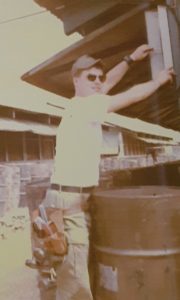 Sergeant Paul Schuler at work
Sergeant Paul Schuler at workPaul had a host of other duties in Saigon. For example, in addition to standing guard duty in a tower overlooking the base, he worked with a staff sergeant to drive prisoners being processed out of Vietnam via Bien Hoa Air Base. He also made deliveries and pick-ups for the NCO club from 7:00 a.m. to 11:00 a.m. every morning, earning an extra $1.25/hour before starting his afternoon telephone repair shift. Although he usually worked alone or with one or two others, he liked the freedom. As long as he got his work done, he could essentially be his own boss. For this reason, he turned down an assignment at the Military Assistance Command – Vietnam (MAC V) Headquarters as he would have been cooped up in an operations center with lots of senior people micromanaging his every move.
Paul particularly enjoyed problem solving. On one occasion, his staff sergeant told him there was a communications emergency at a Vietnamese Army compound. Paul drove a jeep there and found a teletype-like machine that would no longer print. When Paul listened on the machine’s phone line, he heard what sounded like voices on a party line. Over his Vietnamese host’s objections, he walked around the building until he found a phone off the hook and hung it up. When he went back to the teletype, it was again printing properly. Apparently someone had illegally tapped into the teletype line to install a voice phone and the open line prevented the teletype from printing. Even though Paul’s Vietnamese allies could speak no English, their reaction let him know he was now their hero.
Two events occurred during Paul’s tour in Vietnam that every veteran can relate to. First, he was assigned to the Alert Force to defend the base in the event of an attack. More specifically, he was assigned as the M79 grenade launcher operator. The problem was, he had never seen one, so he asked his staff sergeant if he could take a look at it. The staff sergeant said no and when Paul asked why, the staff sergeant said it was because the unit didn’t have an M79 grenade launcher—so much for Paul’s job on the Alert Force. The second event came in February of 1971 when Paul learned his unit was starting to withdraw and that everyone with at least ten months in country would be sent home. Since Paul would have over ten months by February, he looked forward to going home. Then he received the bad news from his First Sergeant—he would not be going home because as a cable splicer, he was too important. So, even though Paul had never spliced a single cable in Vietnam, he was prevented from going home because he had attended cable splicer school after Basic Training.
By this time a Sergeant (E-5), Paul kept busy during his final 45 days in country supervising the phone repair crews who were not yet eligible to go home. With only 23 days remaining, he drove a friend to visit a buddy in Cu Chi. Because it was an off-duty trip and close by, they didn’t take any weapons with them. Once there, they learned that two of the villages they’d driven through were under Viet Cong control. On the way back, they sped through the villages and made sure they were out of the area before dark. Years later, Paul learned that the road they traveled had also been mined.
Paul completed his tour in Vietnam in April of 1970 and departed on a flight out of Bien Hoa Air Base. Remembering his promise to himself when he arrived, he began walking to the waiting airplane. About halfway, he changed his mind and ran the rest of the way. He didn’t want anything to stop him from returning home.
Although Paul was happy to be going home, the thought of returning to a normal life mortified him. He’d learned to survive in Vietnam, with his adrenaline always pumping, so he didn’t know how he’d react back in the states. When he arrived in California, his aunt and uncle took him to dinner. Besides hearing someone call him Paul for the first time in a year, he found himself stopping at the restaurant entrance and checking out the dining area to make sure it was safe. On another occasion as a guy walked in his direction, he clutched his pocket knife and prepared to defend himself. He found it hard to date women because at twenty-one and a Vietnam veteran, he was too mature and different for women his age. He even had to deal with former acquaintances who actually asked him how many babies he’d killed. In short, he was no longer the innocent Catholic boy who’d flown off to Vietnam just twelve months before—he was a soldier. Only after working through these issues with some fellow-Vietnam veterans on his follow-on Army assignment in Germany was he able to feel comfortable integrating back into the civilian world.
Paul was honorably discharged in March of 1972 on an early-out program. He returned to Omaha and his career as an electrician, which he continued until he retired in 2011. He also met and married his wife, LaDona, in Omaha after he returned, and together they raised 5 boys and 2 girls, all of whom are successful in their own right. Paul continues to be active in both the American Legion and the Veterans of Foreign Wars, having previously served as a post commander. He also served on the Omaha Selective Service Board for 20 years.
As Paul looks back, he credits the Army with teaching him to tackle the impossible job, a trait that made him successful as an electrician and something he made sure to pass on to his children. “Follow me” he says, and together we’ll come up with a solution.
Voices to Veterans is proud to salute Sergeant Paul Schuler, U.S. Army, for his unwavering service to our country during the Vietnam War. We are proud to follow you, Paul, and are thankful for your can-do spirit and resourcefulness when our country needed you most.
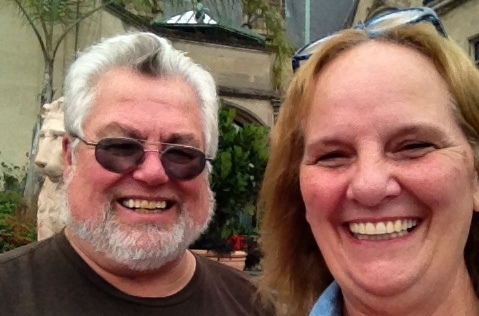 Paul and LaDona Schuler
Paul and LaDona Schuler
April 9, 2019
Airman Ronnie Turner-Winston, U.S. Air Force, Lifetime of Service
Airman Ronnie Turner-Winston, U.S. Air Force, is the kind of veteran I have always admired. She enlisted in the Air Force, served her country in time of war, then returned to civilian life where she serves as a role model for everyone she comes into contact with. She had me laughing and smiling as she told me about her Air Force experience, and I think she will have you doing the same. She will also make you feel proud. This is her story.
Ronnie was born and raised in Washington, D.C., by a single mother. It’s clear from Ronnie’s description her mother is her hero. Her mom had Ronnie while she was still a teenager, which meant her mother had to leave high school during her junior year. Her mother was determined, though, to be both a good mother and a good provider, so she earned her GED and then took classes at the University of the District of Columbia. Ronnie jokes that she should have been awarded the same degree her mother received because she attended 90% of the classes with her mom since her mom couldn’t afford day care. She remembers the look on the faces of her mom’s professors at the start of every semester when her mom would bring her to class for the first time. The professors would scowl, but Ronnie’s mom promised Ronnie would be quiet during class, which she was. This was the beginning of Ronnie’s lifelong love of education.
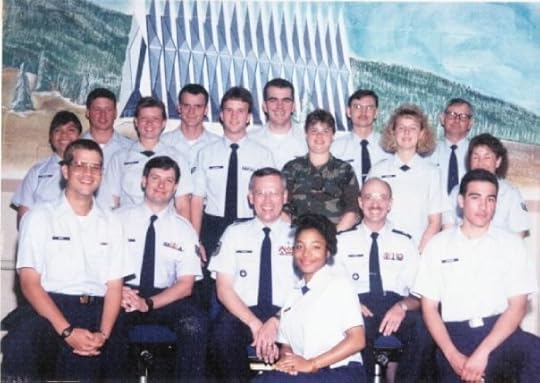 Airman Turner-Winston’s Chapel Management Class
Airman Turner-Winston’s Chapel Management ClassWhen Ronnie was in high school, her family moved from Washington, D.C., to Riverdale, Maryland, where she attended Bladensburg High School. When she reached the end of her junior year, she realized she had no plan for the future. Her mother hadn’t applied to colleges while in high school, so she couldn’t advise Ronnie on what she needed to do. Ronnie did take the SAT, but not the next step of applying to colleges for admission. Ronnie needed someone to point her in the right direction—that’s when the military recruiters stepped in.
Ronnie took the Armed Services Vocational Aptitude Battery (ASVAB) and scored in the upper 90th percentiles. Recruiters for all four military services reached out to her, but it was the Air Force that caught her eye. The Air Force said they were very selective and that won Ronnie out. She enlisted in the delayed entry program and waited for her active duty report date to arrive. In the meantime, she graduated from high school and took classes at the University of Maryland during the fall semester. After she completed the classes, her recruiter began to pester her to provide him with a copy of her transcripts. At age 17 going on 18, obtaining a copy of her transcripts was not a priority for her, so she never got around to it. A few short months later, she would learn why it should have been a priority.
Ronnie reported for active duty in January of the year after she graduated from high school. She boarded an evening flight from Washington, D.C., to San Antonio, Texas. This was the first time she had ever flown in an airplane alone, and she remembers being in awe when she arrived late in the evening in San Antonio. She thought the airport was so cool, she and a couple of other new recruits she met on the flight walked around just soaking it all in. What they didn’t know was that while they were walking around, the bus to Basic Training at Lackland Air Force Base (AFB) arrived and the Training Instructor (TI) had to hold up the bus waiting for them. When they finally made it to the bus, the TI yelled at them for being late and told them no one had authorized them to walk around. With no prior exposure to the military, Ronnie’s only thought was “what have I gotten myself into?”
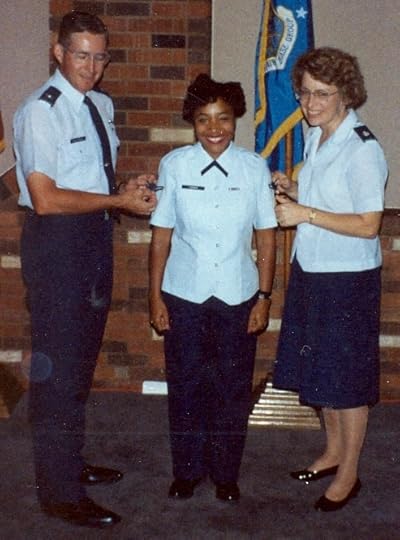 Airman Turner-Winston promotion ceremony
Airman Turner-Winston promotion ceremonyThe bus arrived at Lackland AFB around 2:00 a.m. and Ronnie was exhausted. The TI explained on the bus that they would be going to the chow hall to get something to eat. He also said recruits would be expected to drink two glasses of water with every meal to help protect them from the heat in San Antonio. Still not grasping she was no longer a civilian, Ronnie asked the TI if she could skip the chow hall and go directly to her barracks to get some sleep since it had been such a long day. This resulted in the TI recalibrating Ronnie for a second time, and she hadn’t even started in-processing yet. In the end, she drank her water and got checked in, beginning her tour in the Air Force.
Ronnie remembers an Asian-American woman in her flight of trainees who had long, beautiful black hair. It was so long, Ronnie estimated it had to weigh at least 5 pounds. The Air Force wouldn’t make her cut it as long as it remained neatly styled on her head. The problem was, it was so heavy, it kept falling off—sometimes during formation—so Ronnie and some of the other women in her flight tried to help style the woman’s hair so it would stay in place. Once Ronnie even broke formation to help the woman put her hair back in place. As you would expect, all of these instances resulted in angry TIs yelling at those involved, but the real result was increased camaraderie in the unit as the flight pulled together to help one of its own.
Ronnie hadn’t gotten any commitment before she enlisted regarding what job she would do. When the job specialty discussions began, she gravitated toward becoming a chapel manager. She had grown up in the church so it was a natural fit for her. When she learned she could also have time off during the week because she would work weekends at the chapel, she was all in. So, after graduating from Basic Training, Ronnie headed off for eight weeks of Chapel Management School at Keesler AFB near Biloxi, Mississippi. Ronnie made lasting friendships at Chapel Management School and still maintains contact with her classmates to this day.
Ronnie graduated from Chapel Management School as an Airman Basic (E-1). Had she provided her University of Maryland transcripts to her recruiter, she might have qualified for a higher paygrade and more money, but it was too late for that now. She reported to her first duty station at the chapel on Wright-Patterson AFB near Dayton, Ohio. Her first choice was Andrews AFB just outside of Washington, D.C., but Wright-Patterson was still a good location because her stepfather’s family lived in Dayton. Shortly after Ronnie arrived, a junior chapel manager at Chanute AFB in Rantoul, Illinois, wanted to swap duty stations with Ronnie, which the Air Force allowed. Thinking a few additional miles from Washington, D.C., wouldn’t matter, Ronnie accepted the transfer to Chanute.
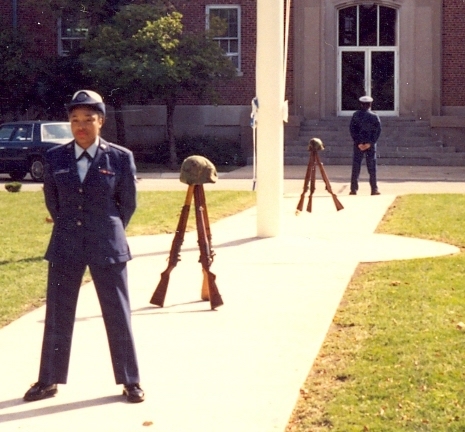 Airman Turner-Winston standing ceremonial guard
Airman Turner-Winston standing ceremonial guardRonnie loved her assignment at the Chanute chapel, which was a very close-knit community. She especially enjoyed volunteering for any ceremonial duties like parades or standing special guard duty, but there were much more mundane duties involved, as well. For example, one of the first things she was told to do was to make the weekly deposit at the base bank. Much to everyone’s surprise, Ronnie said she couldn’t do it because she didn’t have a driver’s license. For the next two weeks, Father Raul taught her how to drive using his car, which was stick shift. Once Ronnie learned to drive, Father Raul even helped her get her first car. The next surprise came when she was asked to shovel snow—she had never had to do that in Washington, D.C., where it snowed so infrequently and melted so quickly that shoveling was never an issue. She learned quickly in Illinois, though, that shoveling snow around the chapel was part of her job description.
In late 1990, war came to the Middle East when Iraq invaded Kuwait. Having grown up during the relative peace of the Cold War, Ronnie hadn’t expected the United States to be involved in an armed conflict, although the U.S. intervention in Panama in 1989 certainly alerted her to the possibility. Yet, when Desert Storm came, Ronnie was the first person in her chapel to get orders. She deployed in support of Desert Storm for approximately two-and-a-half months. It was an experience she will remember for the rest of her life.
After the Gulf War ended, Ronnie returned to the chapel at Chanute, where she continued her duties. When she was nearing the end of her initial four-year enlistment, she was asked to reenlist for another four years so she could be given orders. Ready to settle down, Ronnie decided not to reenlist and instead took the opportunity for an early out. She was discharged in September 1993 after serving over three years on active duty.
Once back in the civilian world, Ronnie completed cosmetology school. Although she enjoyed the work, she changed jobs and took a position in Human Resources at Parkland Community College in Champaign, Illinois. Her Parkland job re-opened the doors to her education. She went on to earn her Associate’s Degree from Parkland and her Bachelor’s and Master’s Degrees from Eastern Illinois University, all while raising her family. She loves learning so much, she is currently pursuing her Doctor of Education degree in organizational leadership with Grand Canyon University.
Ronnie has gone far beyond studying leadership—she practices it in the community every day. In fact, Ronnie believes everyone must take responsibility for supporting their community. For Ronnie, this means serving as the Adjutant for American Legion Post 559 and as a member of VFW Post 5520, and as the Veterans Affairs Representative for the Champaign County NAACP. She is also seeking to establish a local chapter of the National Association of Black Veterans (NABVETS). On top of all that, Ronnie is committed to her four children and two grandchildren, a commitment she reinforces by serving as an officer in both the Urbana High School and Middle School PTSAs.
Voices To Veterans salutes Airman Ronnie Turner-Winston for her outstanding service to our nation in the Air Force during the Gulf War and for her continued commitment to public service in the community. She is an outstanding role model, exemplifying duty and honor in everything she does.
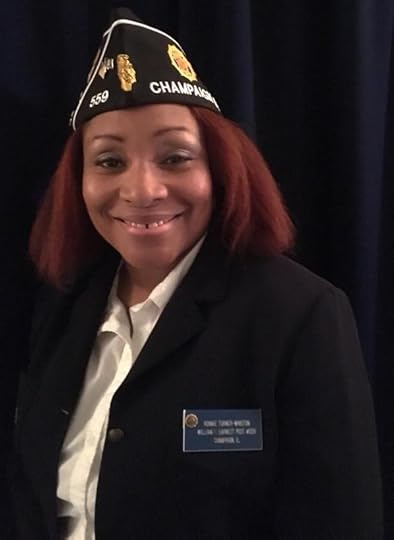 Ronnie Turner-Winston, Adjutant for American Legion Post 559
Ronnie Turner-Winston, Adjutant for American Legion Post 559



